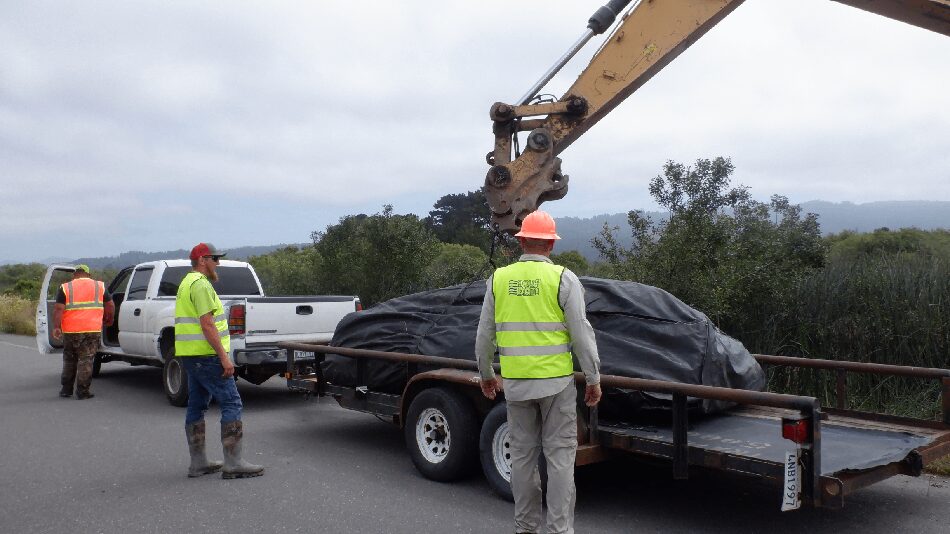
The 4ft tall AquaDam® unrolled into deep water caused by excavation during plant removal, making a larger unit necessary. A 6ft tall, 13ft wide, 270ft long SCE AquaDam® was then installed north of the original. AquaDams® are shipped rolled around a beam, protected, and equipped with lifting ropes or straps for safe handling.
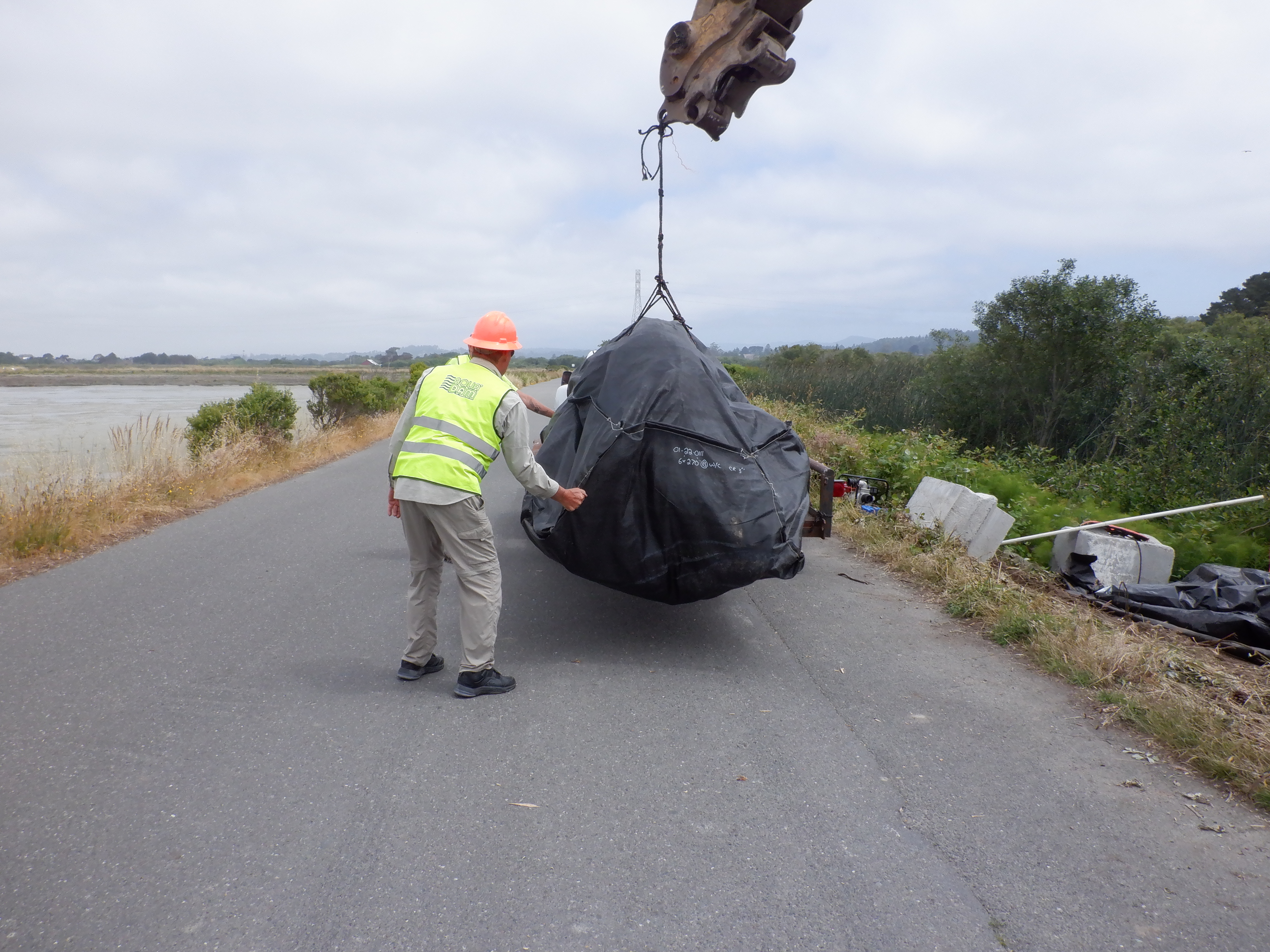
Utilizing an excavator and lifting ropes, the 6ft tall SCE AquaDam® was removed from its transport trailer.
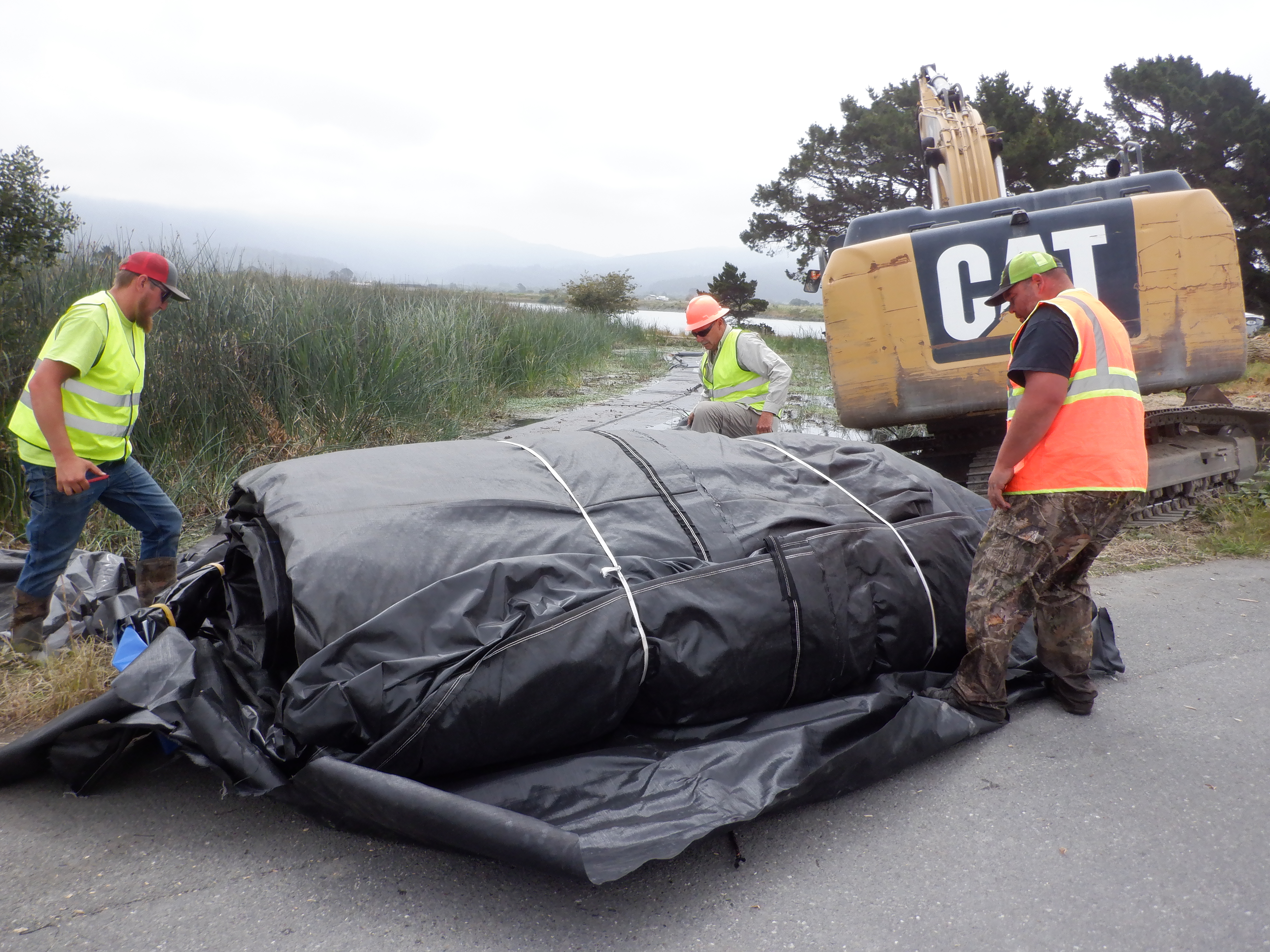
The SCE AquaDam® was positioned at its starting bank, ready to unroll into the water. Workers removed ropes and covering. For success, the starting bank must elevate the open end above the AquaDam®'s full height for proper filling and stability. The open end and fill-tubes must stay elevated along the path. An AquaDam® reaches its max height only at the lowest point.
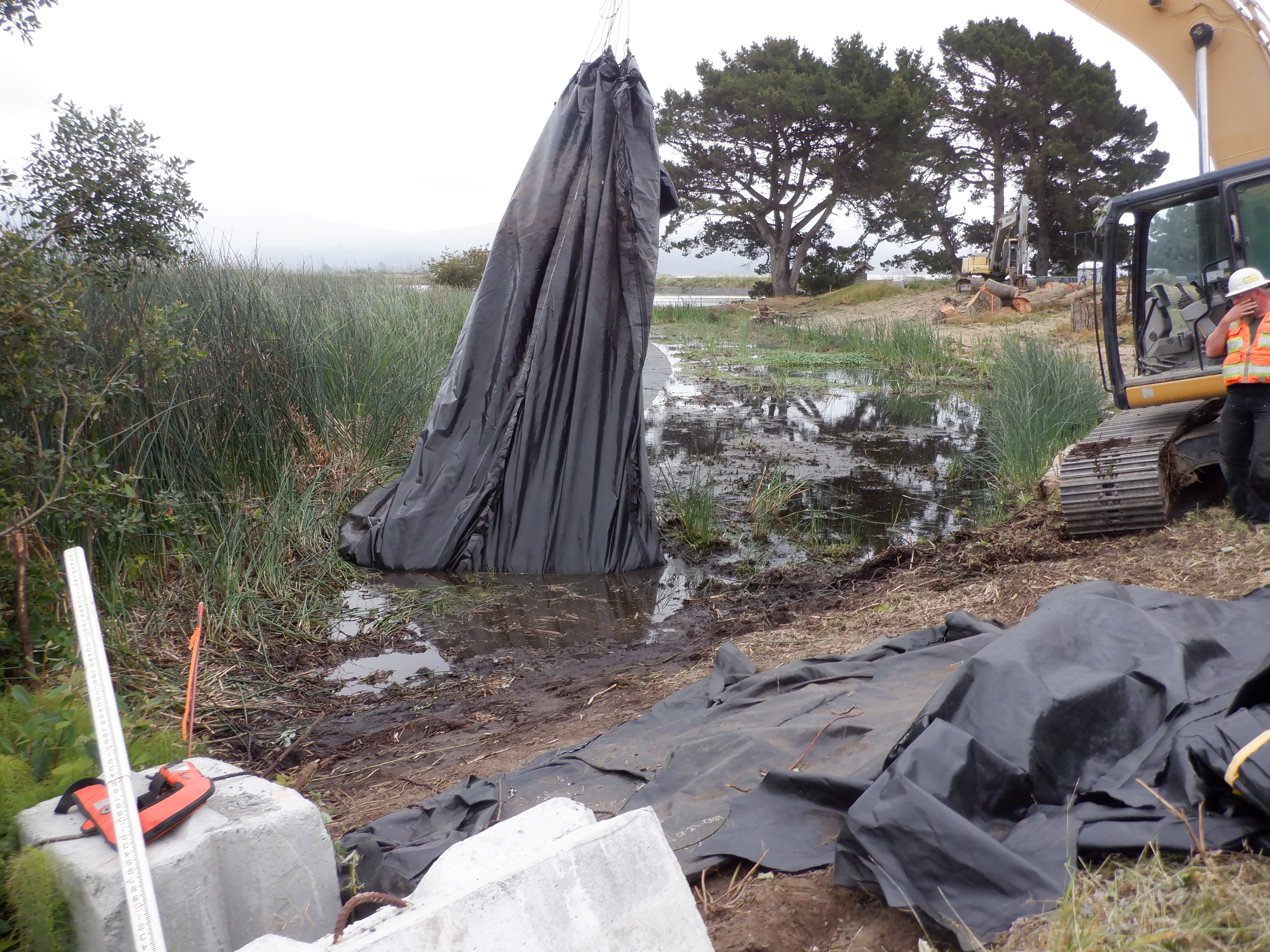
To facilitate the placement of the 6ft tall unit, the open end of the 4ft SCE AquaDam® was temporarily elevated and moved clear.
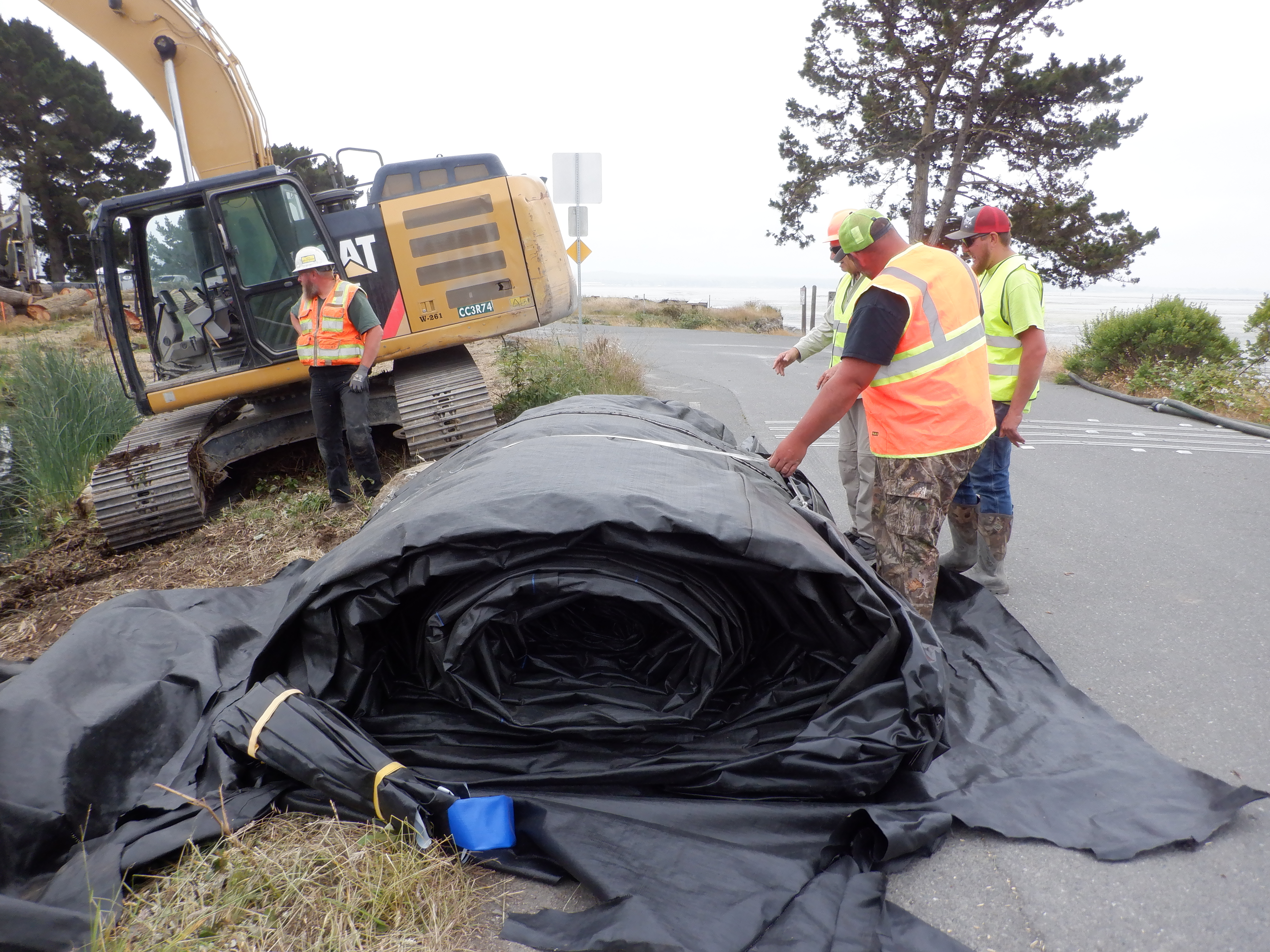
With the path cleared, workers proceeded to cut the white retaining line that had been used to secure the AquaDam® roll during transport.
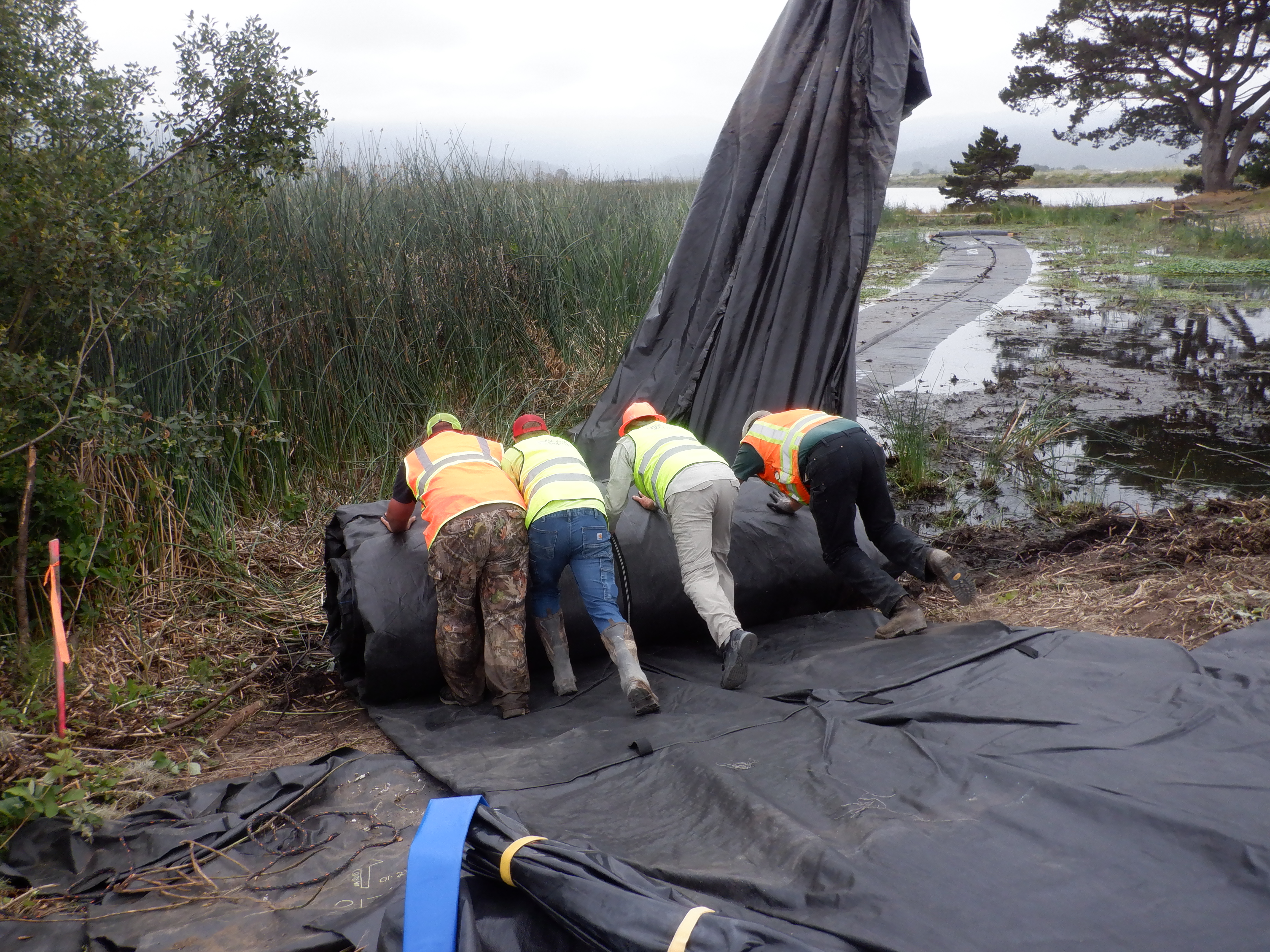
Workers unrolled several feet of the AquaDam® to expose the fill-tubes and extend the unit to the water’s edge. One of the fill-tubes can be seen in the bottom left, identified by the yellow Velcro straps and the 3in blue discharge hose.
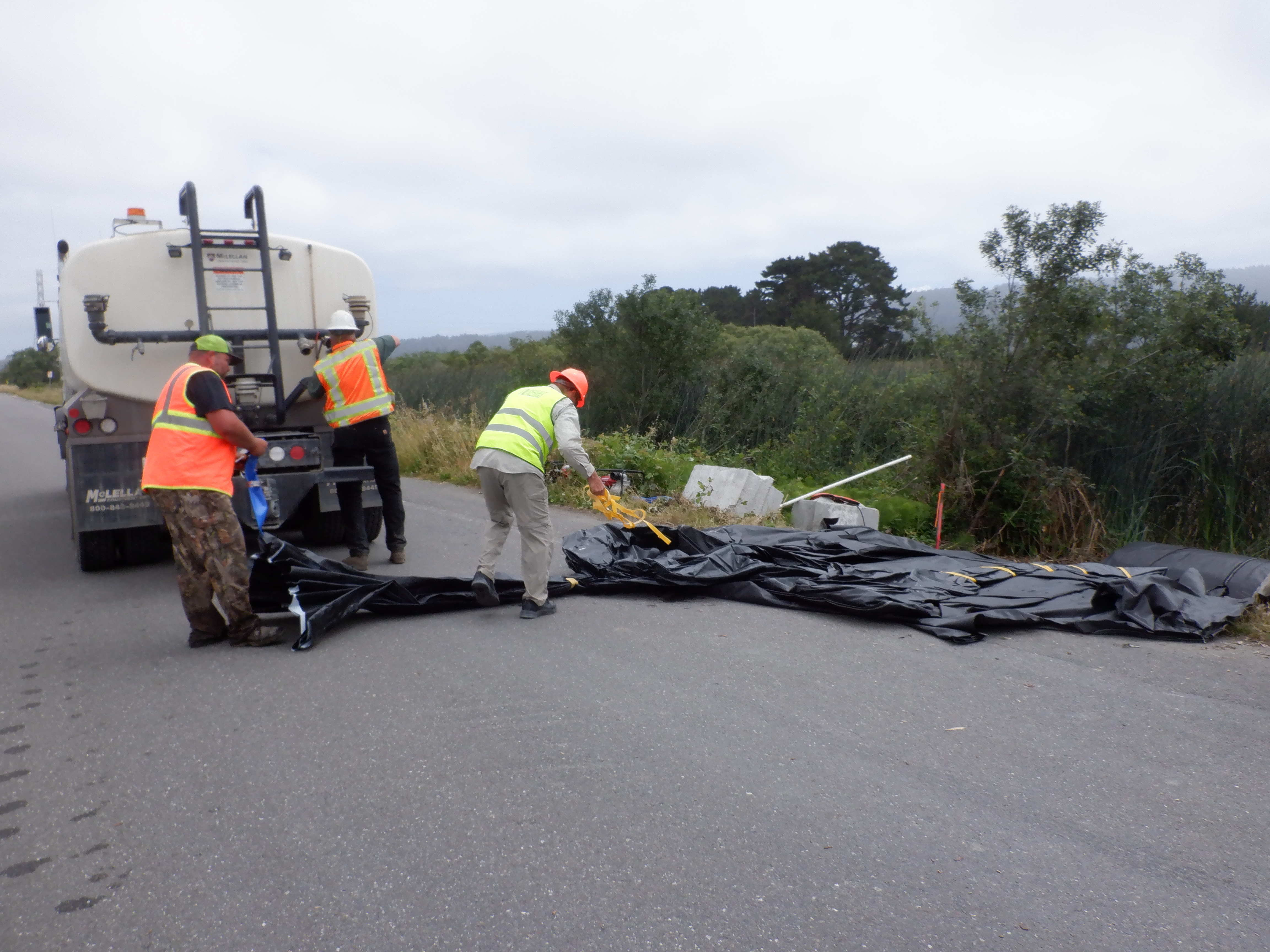
Due to permit restrictions prohibiting the use of water from Hauser Marsh, water trucks were required to fill the AquaDams® with potable water. Workers positioned s discharge hose from the water truck to the AquaDam® fill-tubes to begin the filling process.
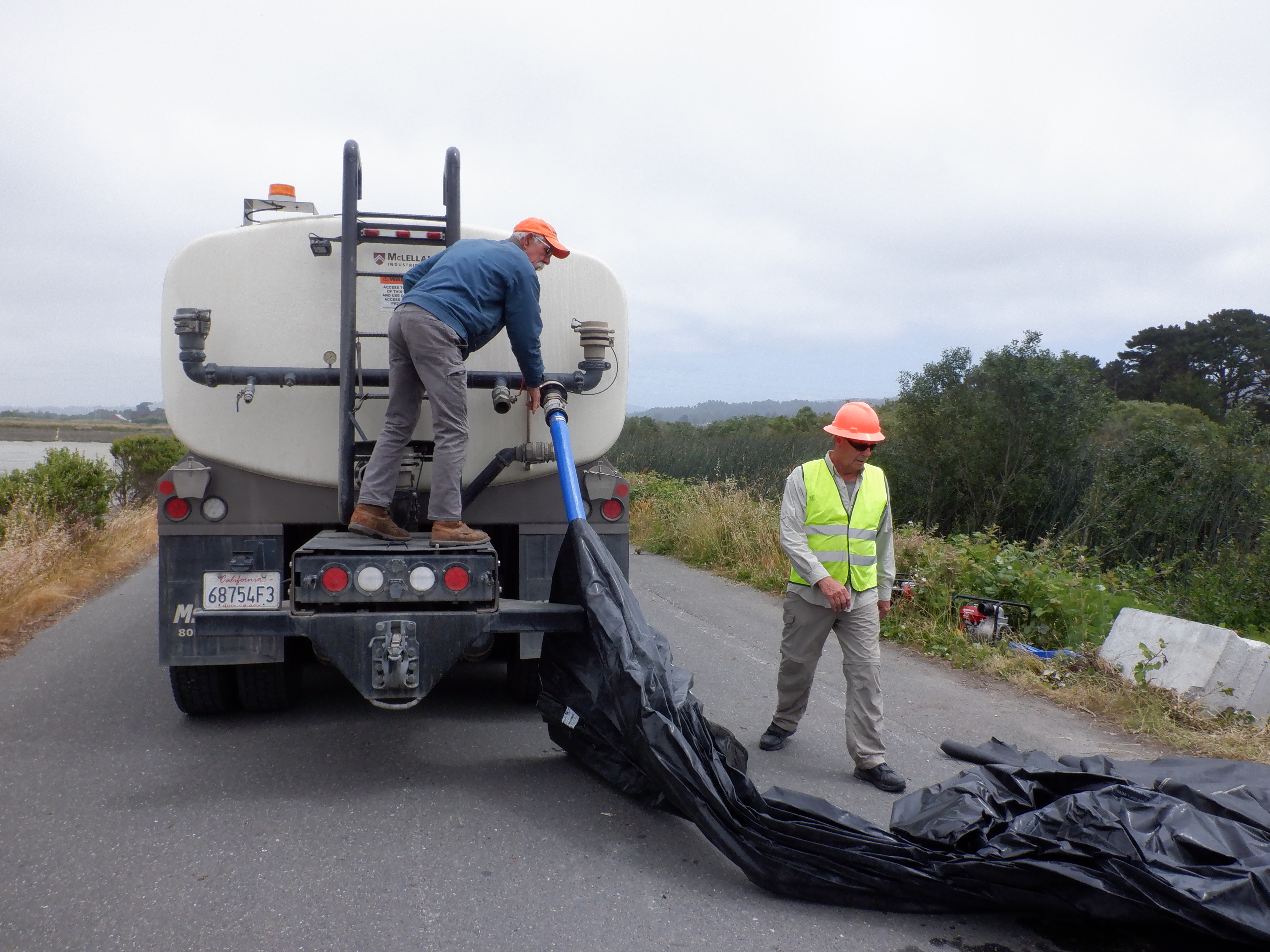
The water truck was capable of filling only one side of the AquaDam® at a time.
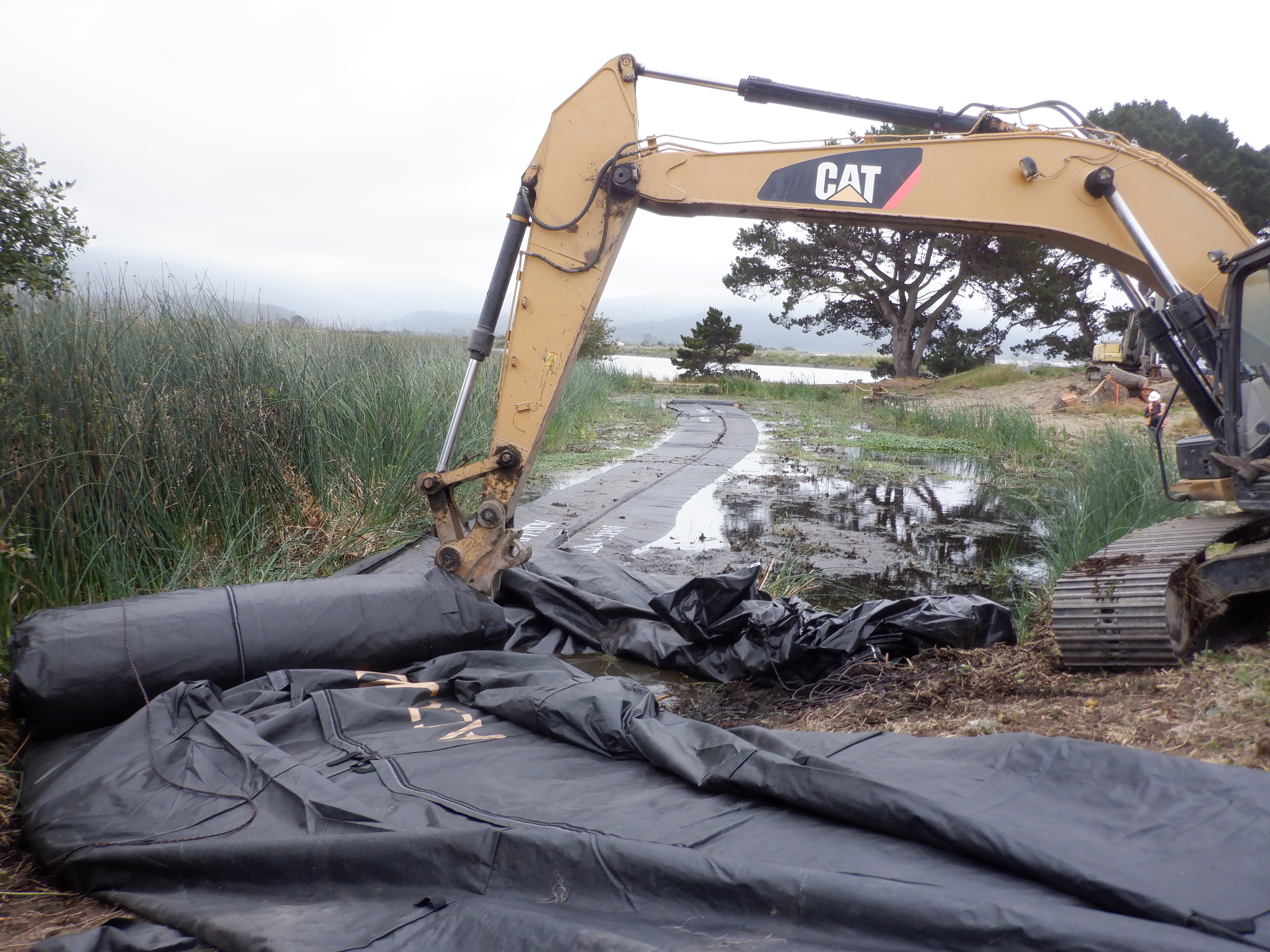
The excavator's arm was employed to stabilize the right edge of the roll, ensuring it remained in position.
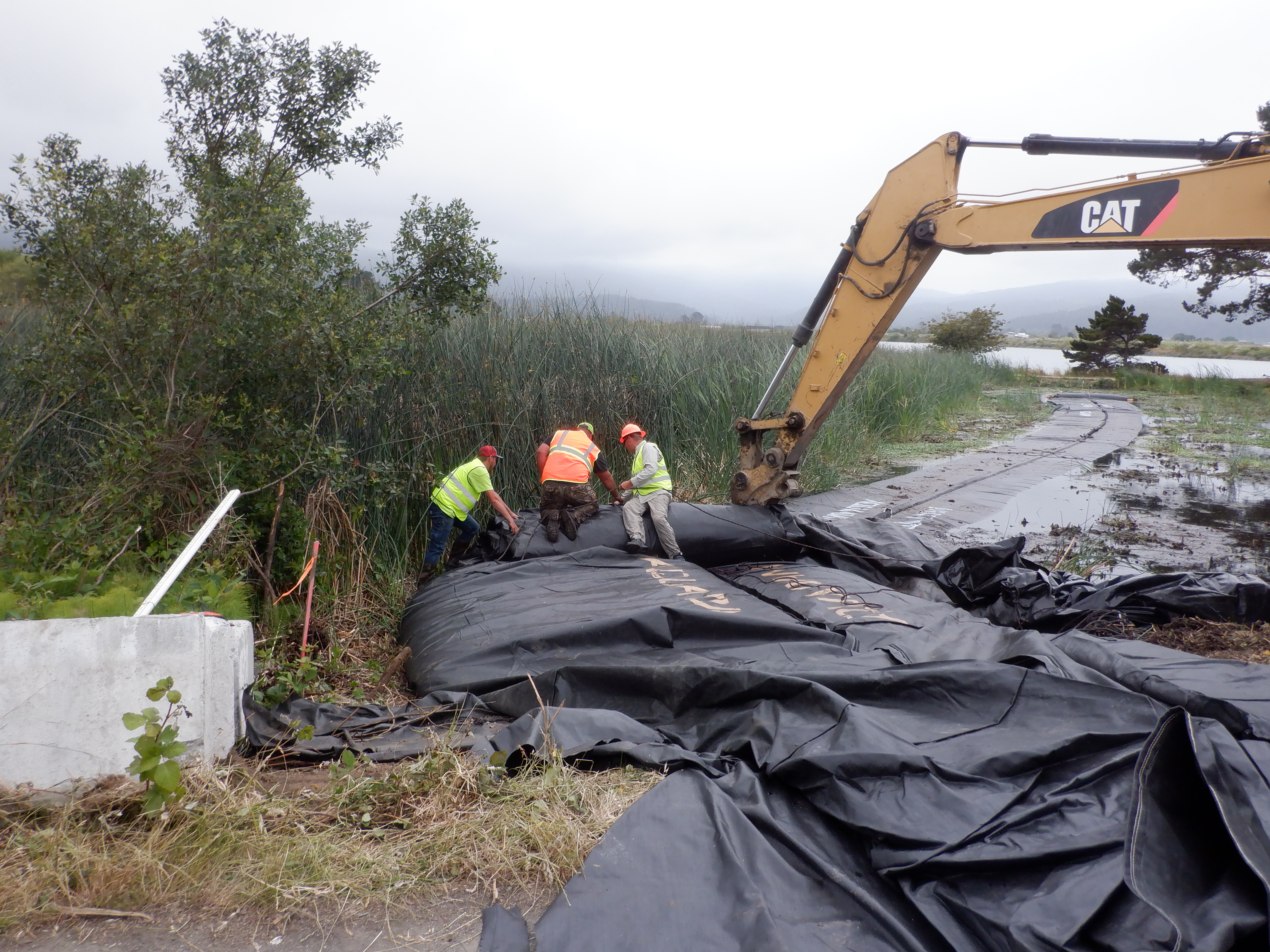
As the 6ft tall SCE AquaDam® continued to fill, workers used ropes to restrain the remaining roll and maintain its alignment during deployment.
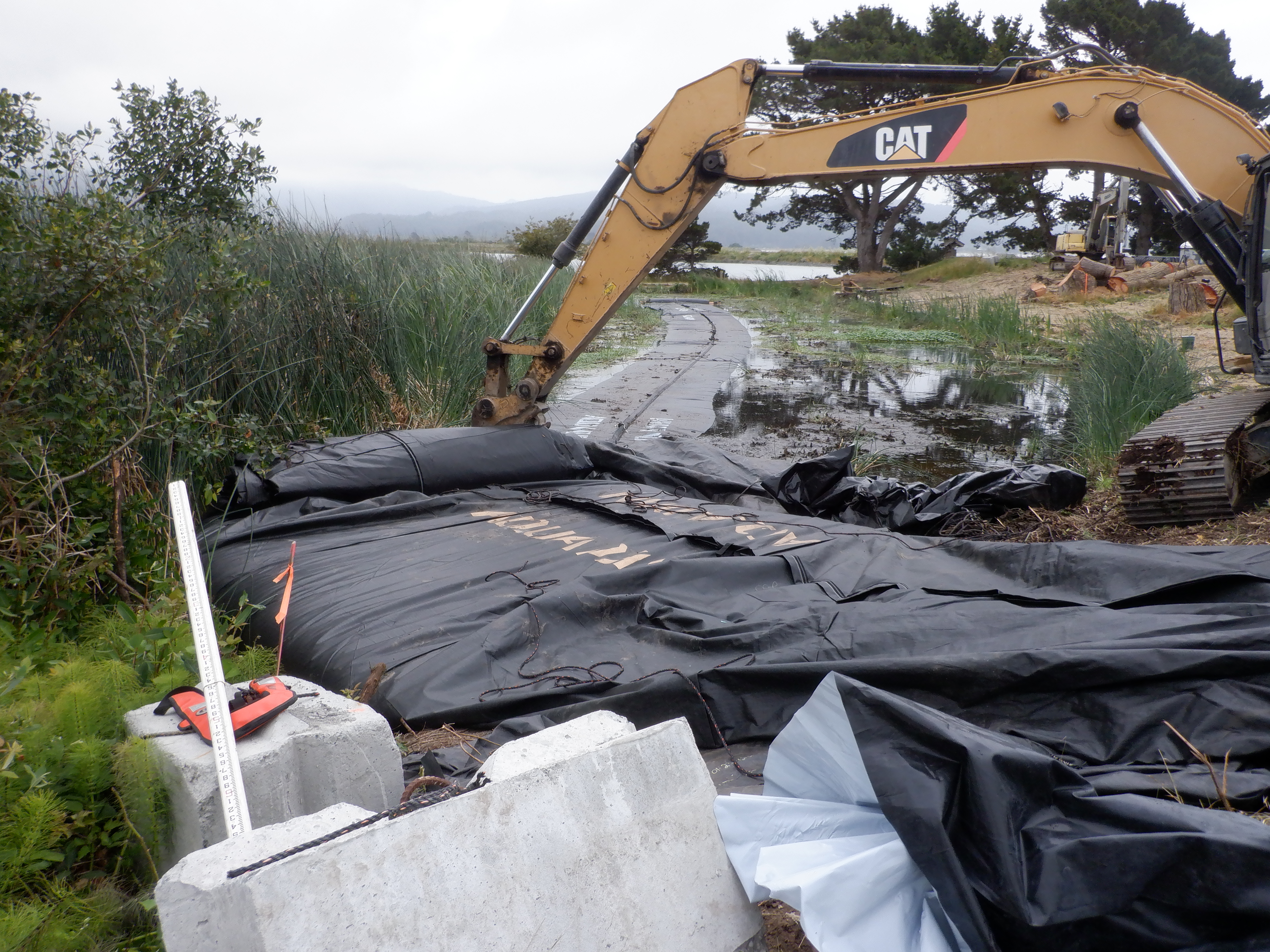
The excavator arm was re-positioned to the tule side of the roll to assist in building hydraulic head within the body of the AquaDam®.
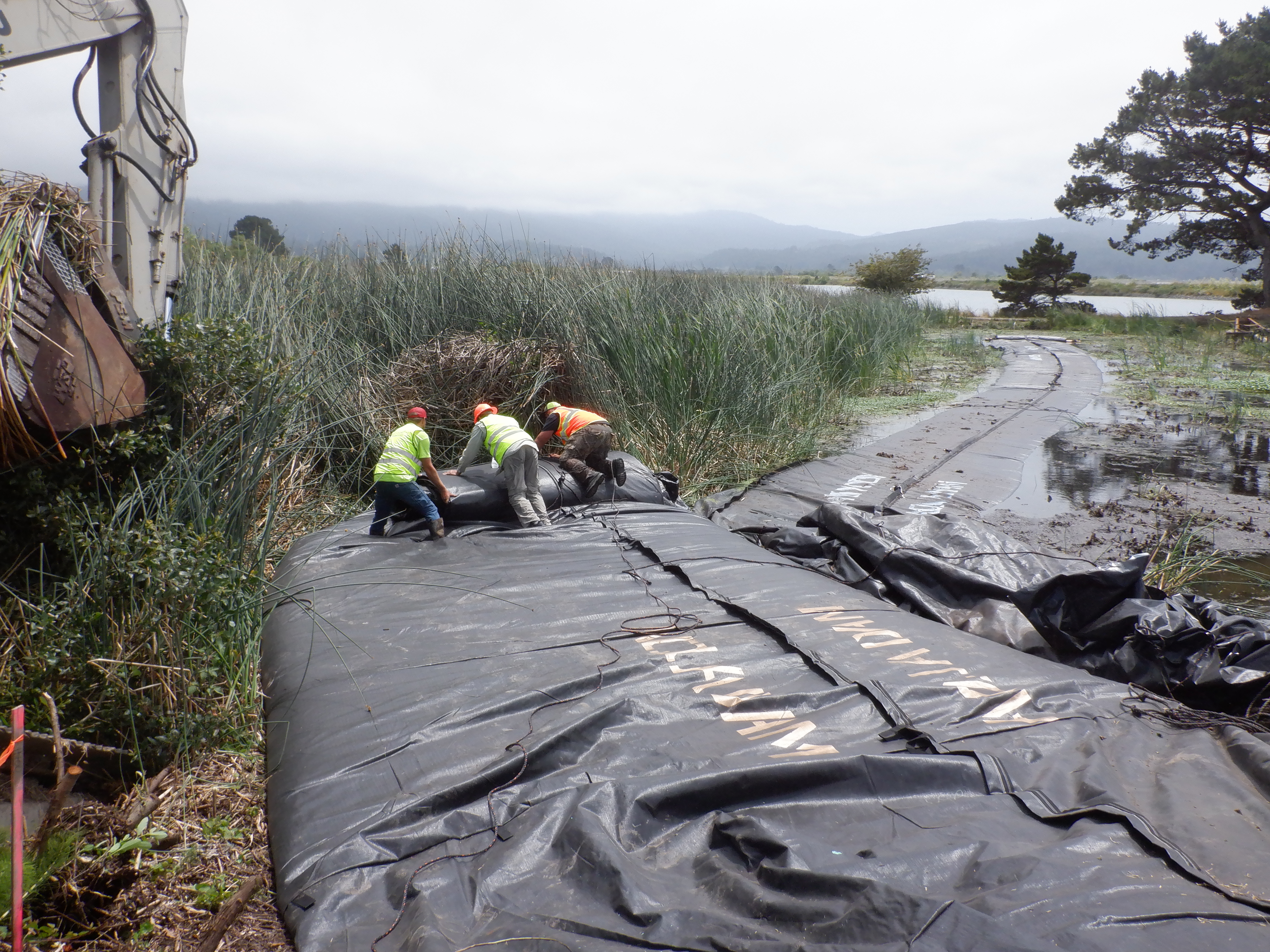
To achieve proper alignment, workers manually lifted and guided the AquaDam® roll into position. Their objective was to place the roll directly over the tules, following the waterline for optimal placement.
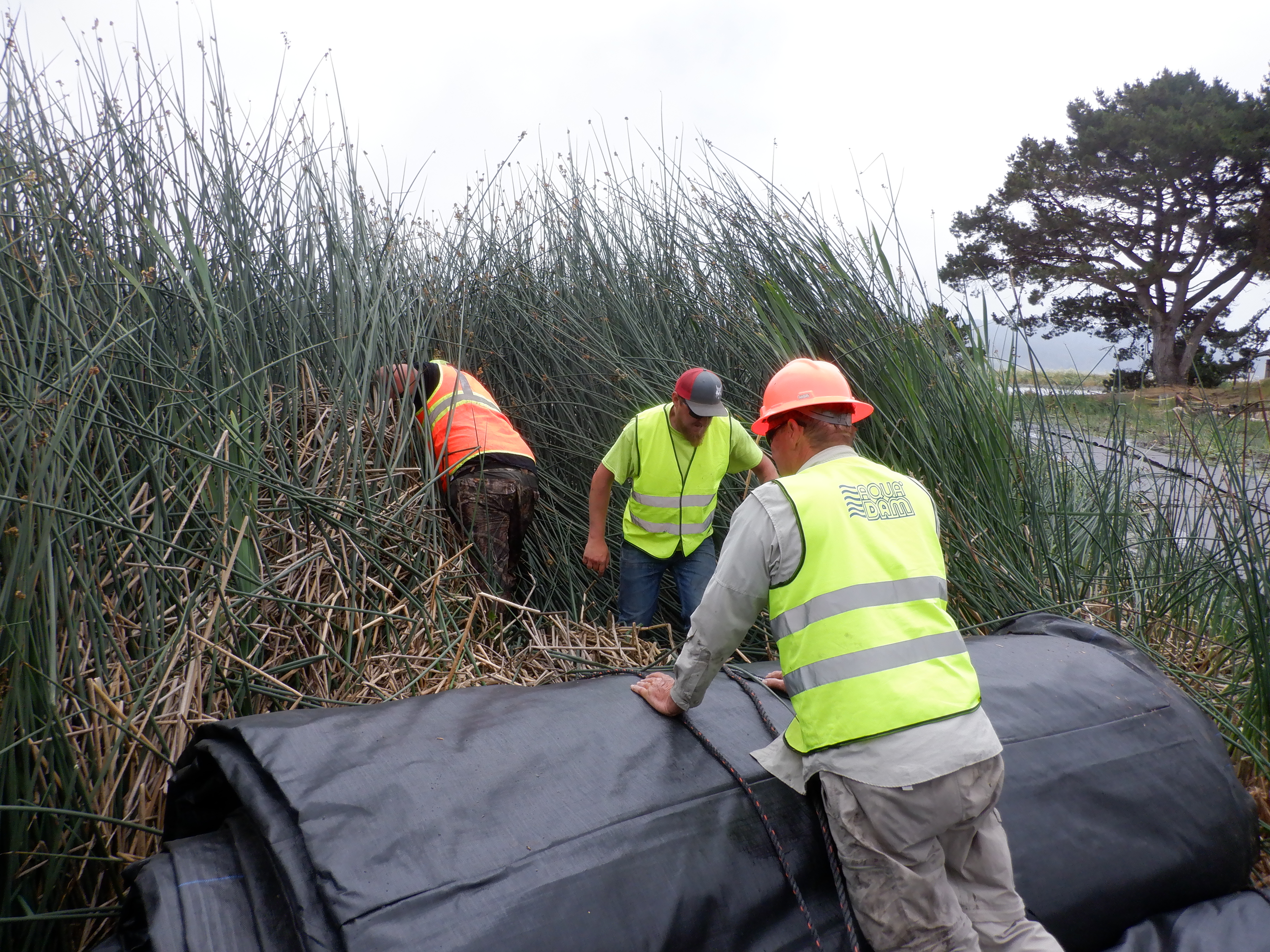
The 8-to-10ft tall tules, floating on the water, posed a challenge. Workers began stepping on them to flatten them, creating a clear path for the AquaDam®.
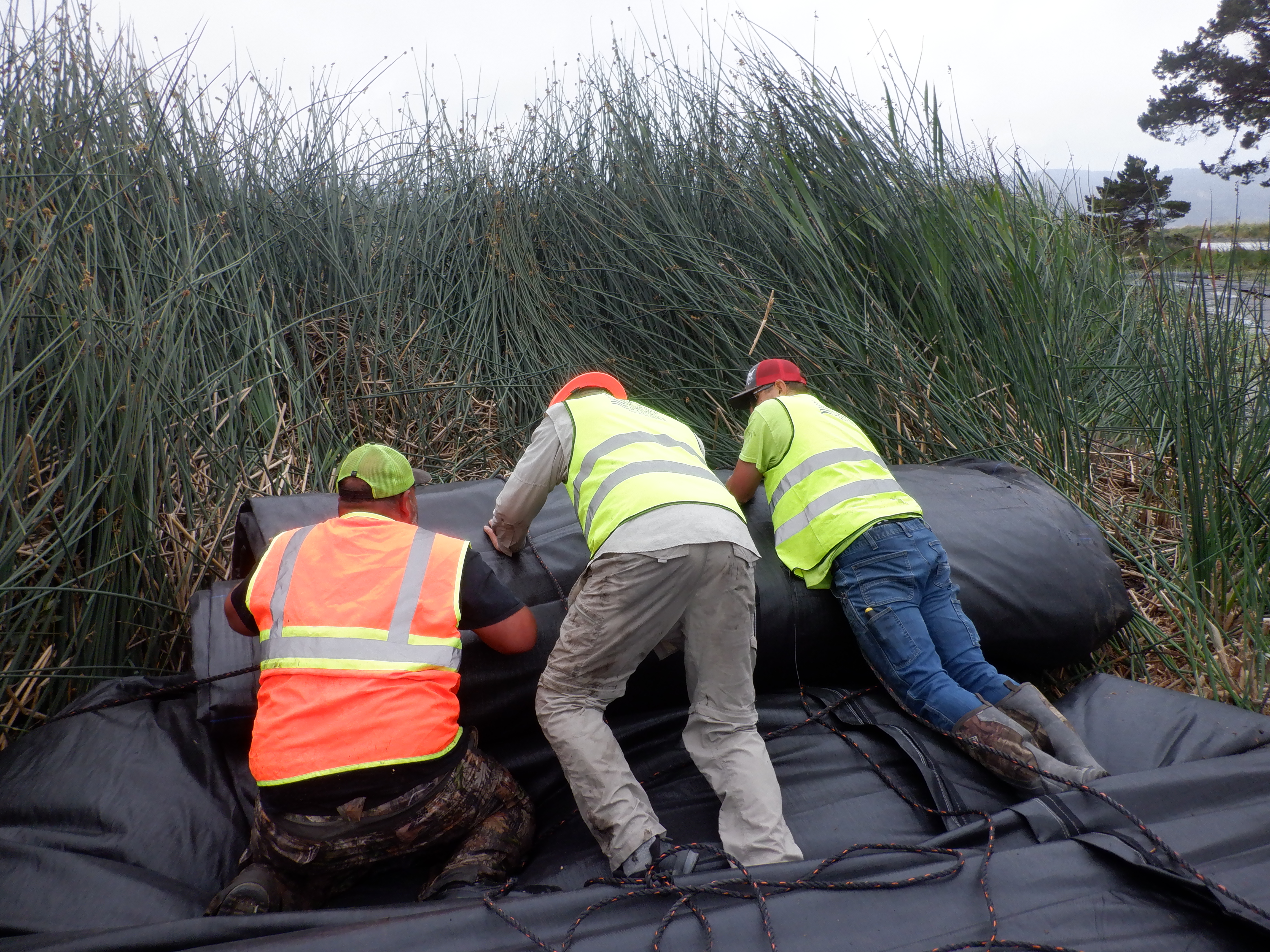
With the tules partially pressed down, workers continued guiding the AquaDam® roll by pushing it gently across the flattened vegetation, steering it into the intended deployment path.
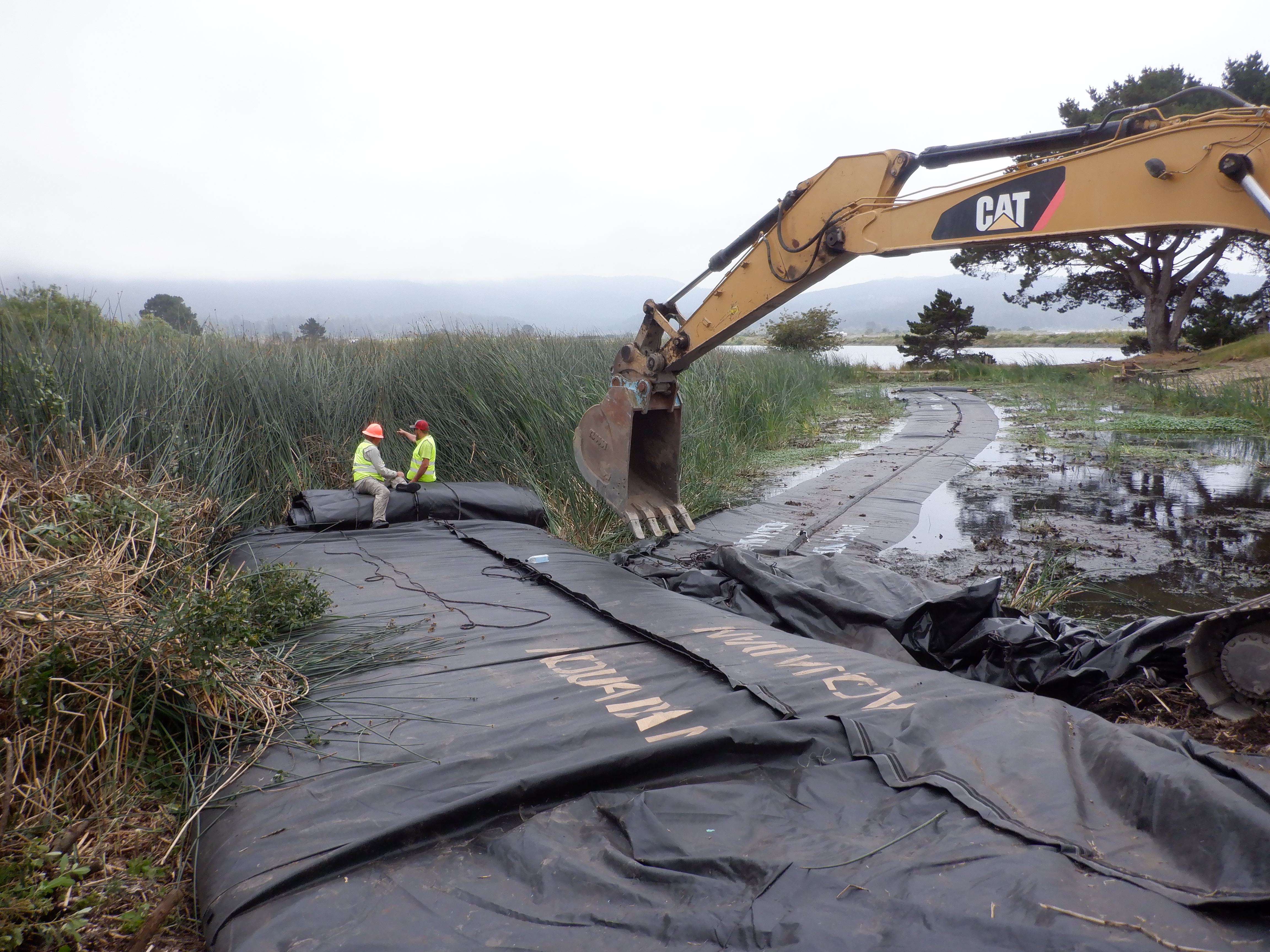
Installation of the AquaDams® proceeded slowly due to the one-truck-at-a-time filling method. Standard practice generally recommends filling AquaDams® using pumps that draw directly from the surrounding body of water.
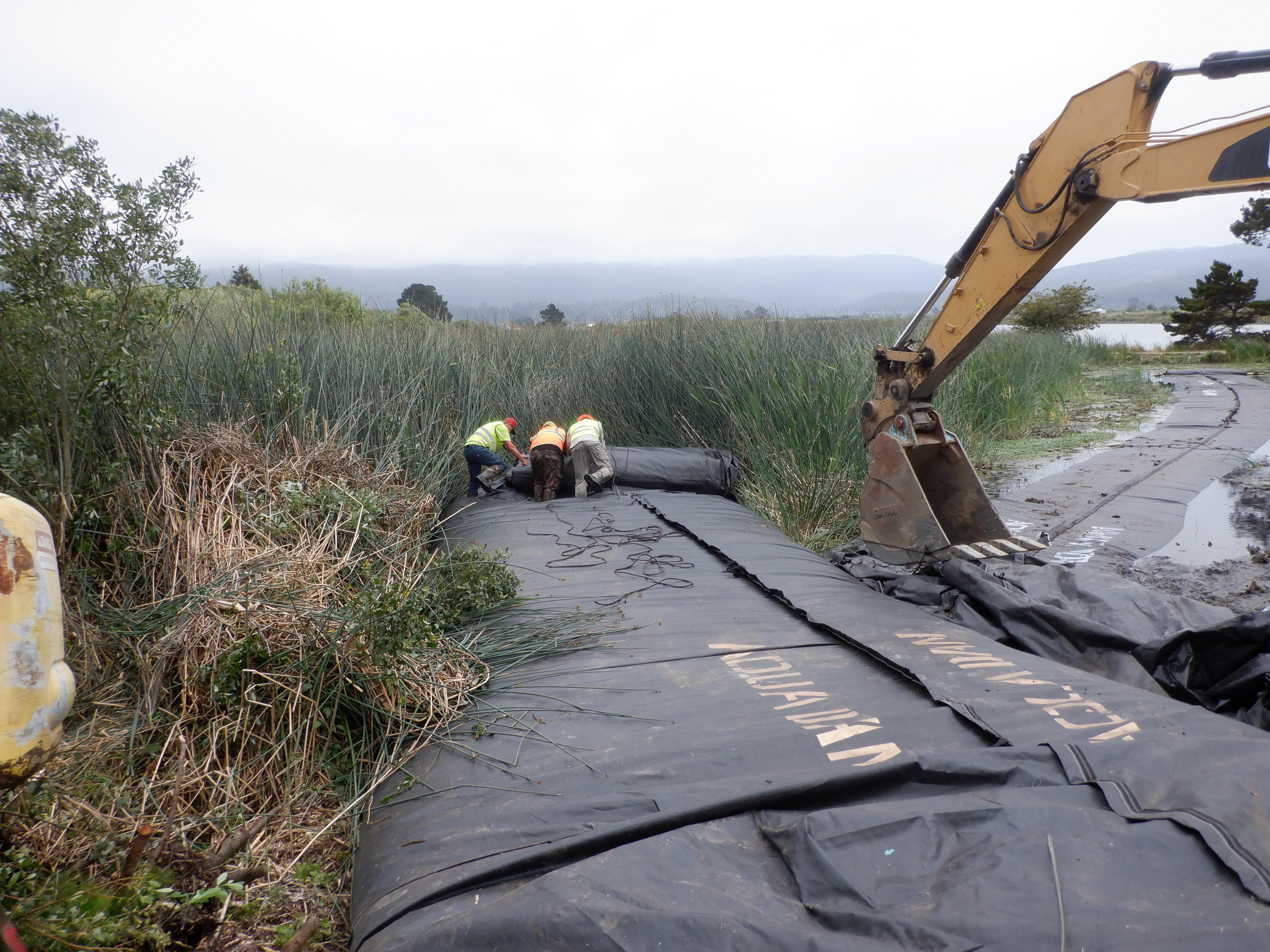
After the 6ft tall SCE AquaDam® developed several feet of hydraulic head above the surrounding water level, workers guided the roll into the desired alignment.
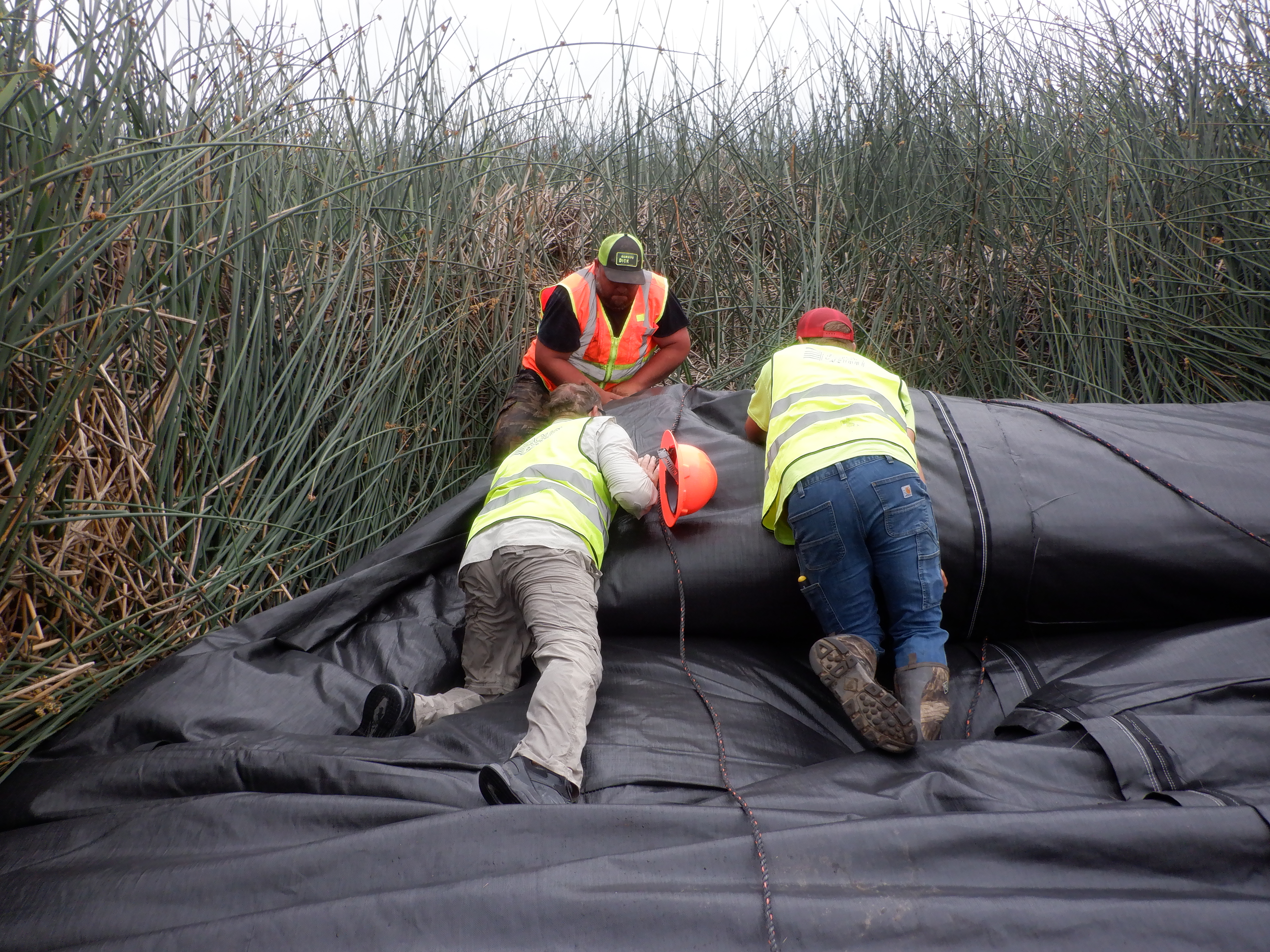
Workers continued managing the dense tule vegetation to prevent the AquaDam® from drifting off course during deployment.
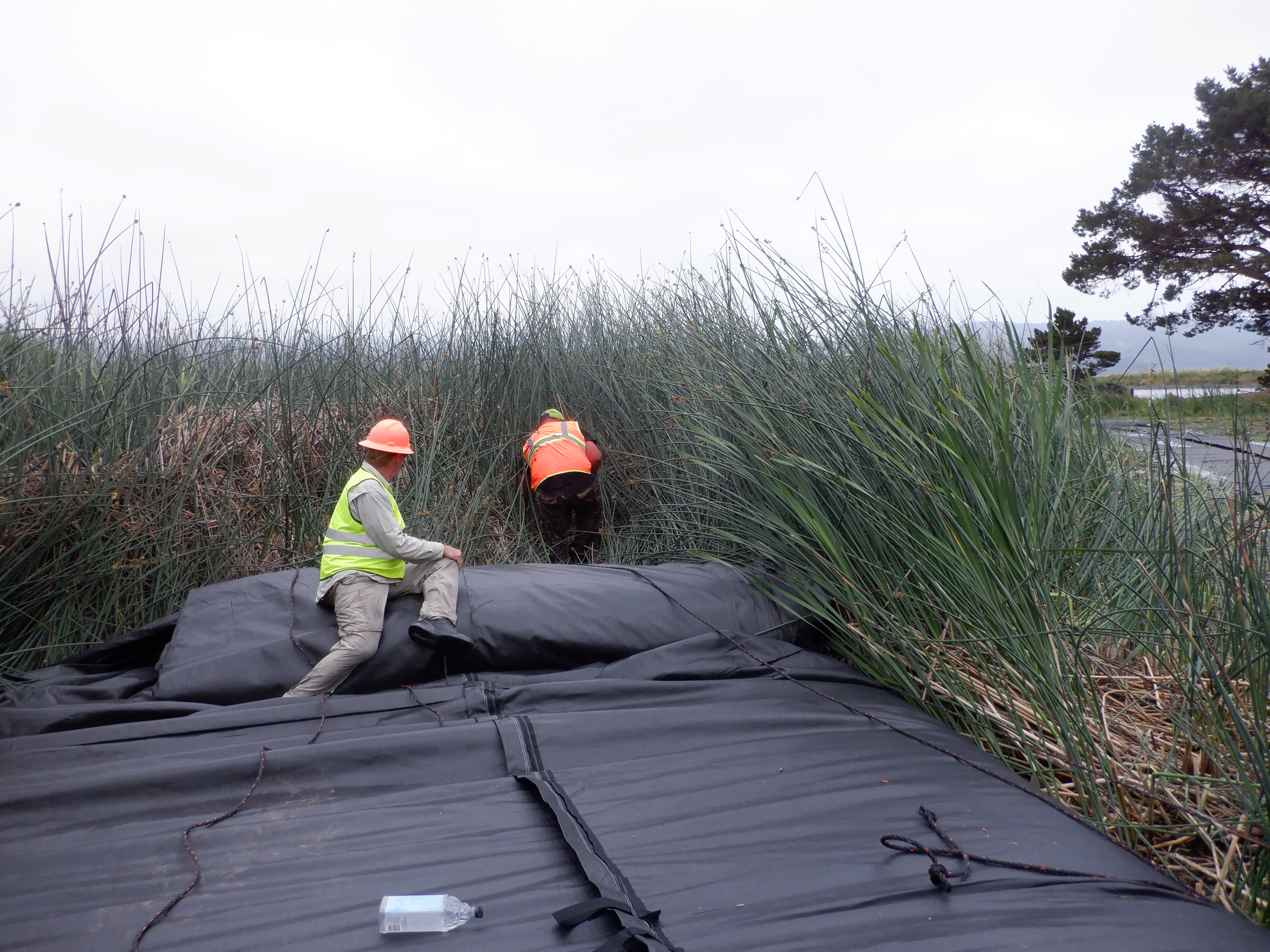
Workers ventured into the tule stands, stepping onto the vegetation to press it down and clear a path for the AquaDam® to advance.
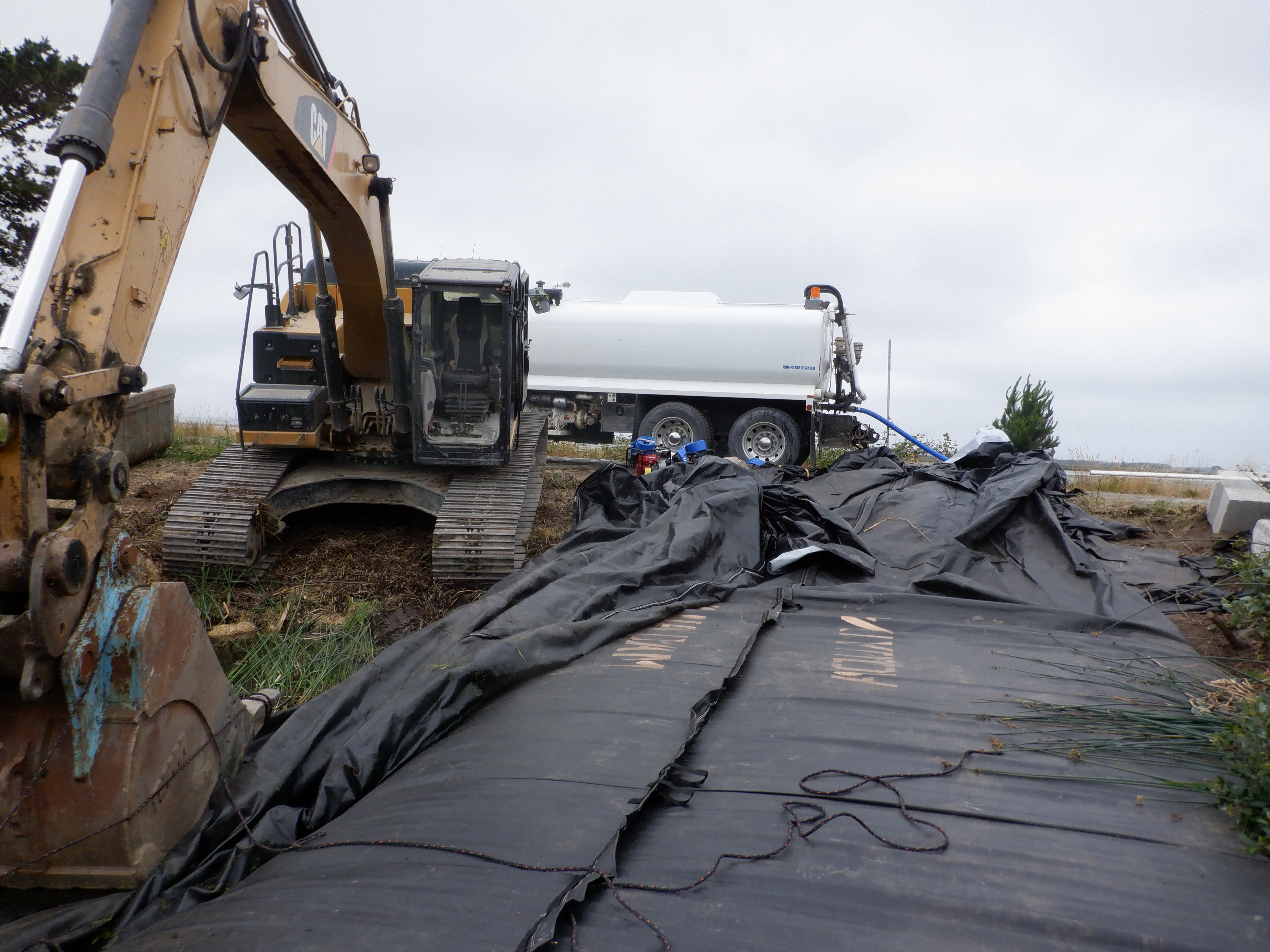
This view looks back toward the starting bank of the 6ft tall SCE AquaDam®. Notably, a single blue discharge hose is being used to fill the unit.
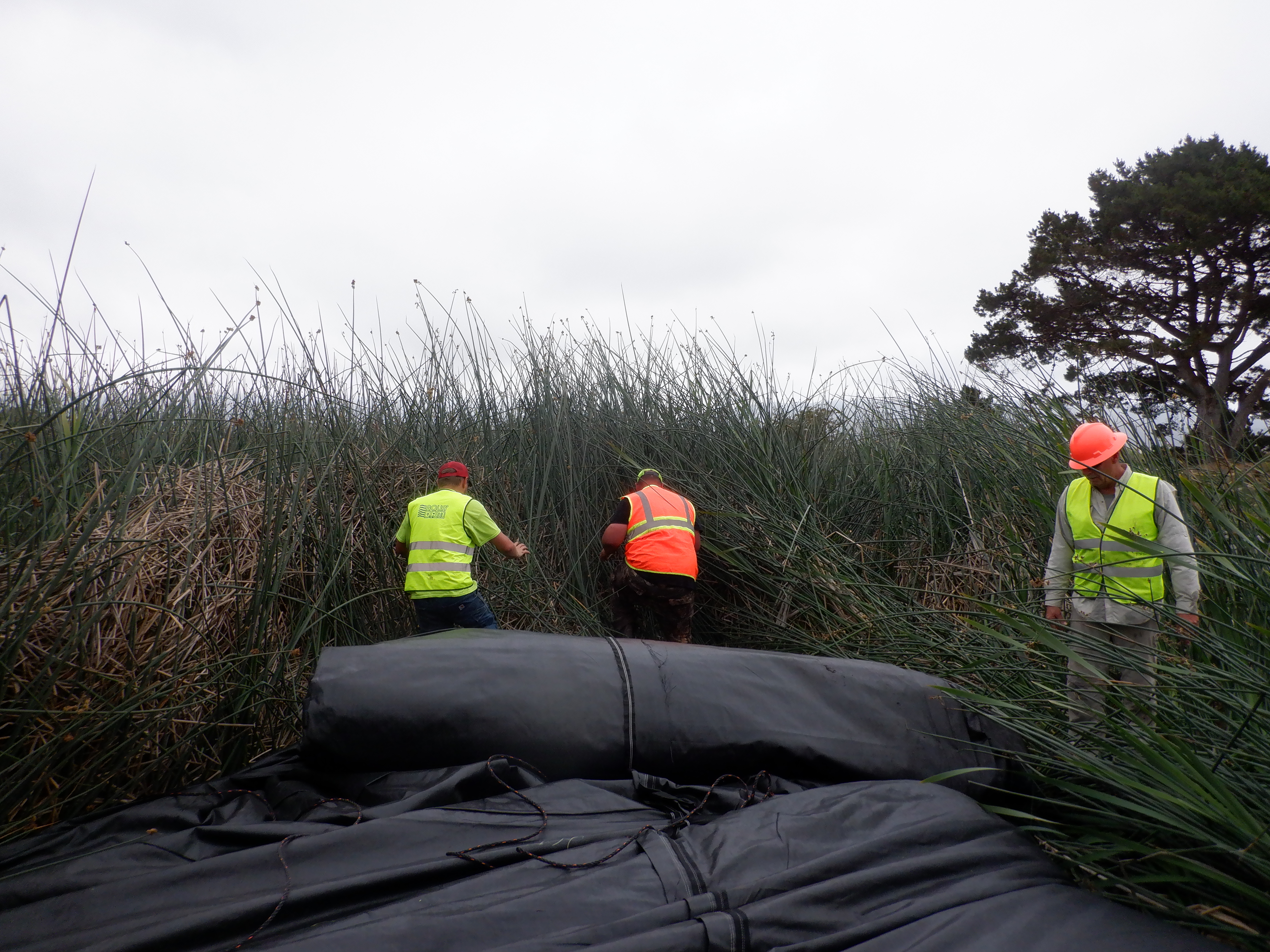
As the 6ft tall SCE AquaDam® gained head, workers walked ahead and pushed down the tules to clear its path.
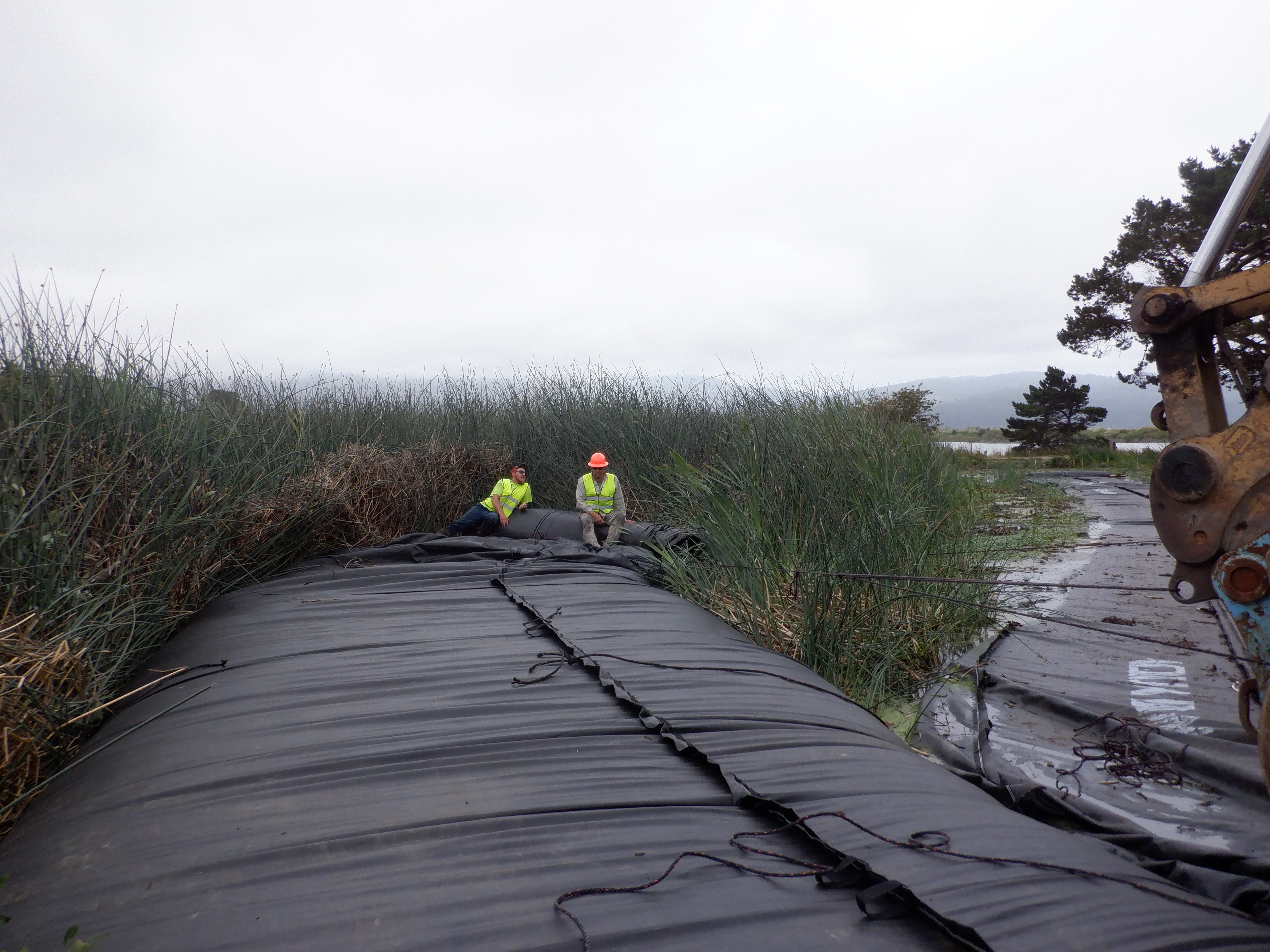
A large mass of dead vegetation, visible to the left of the workers, obstructed the path, requiring the AquaDam® to be maneuvered around it.
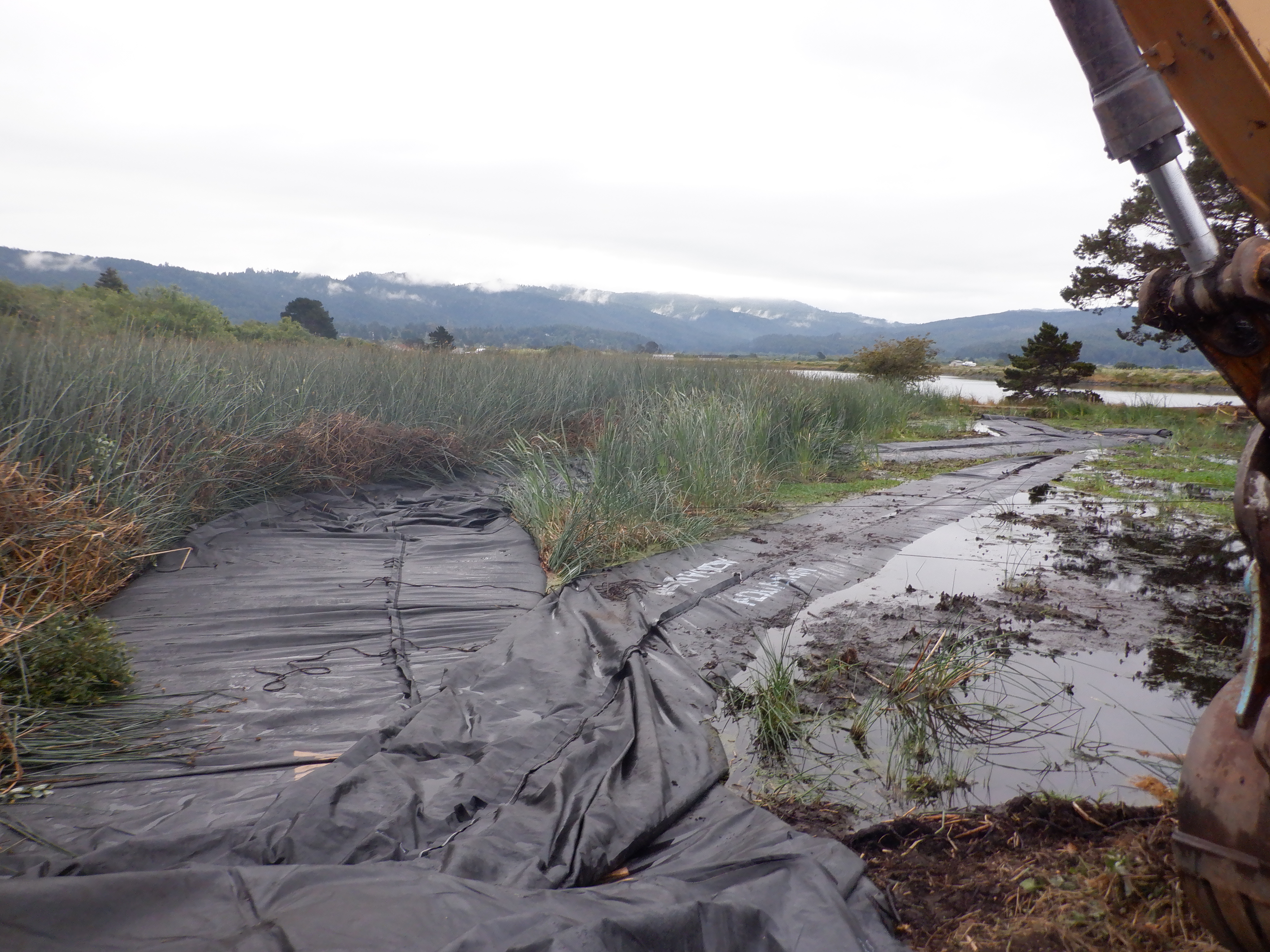
The 6ft tall SCE AquaDam® naturally settled into the lowest elevation point and proceeded in that direction. Prior to installation, the area had been “prepared” using a specialized rake intended to clear some of the tule vegetation. However, this preparation inadvertently created additional challenges by disturbing the substrate and leaving root balls behind. These irregularities in the bottom profile contributed to the AquaDam® veering off course during deployment.
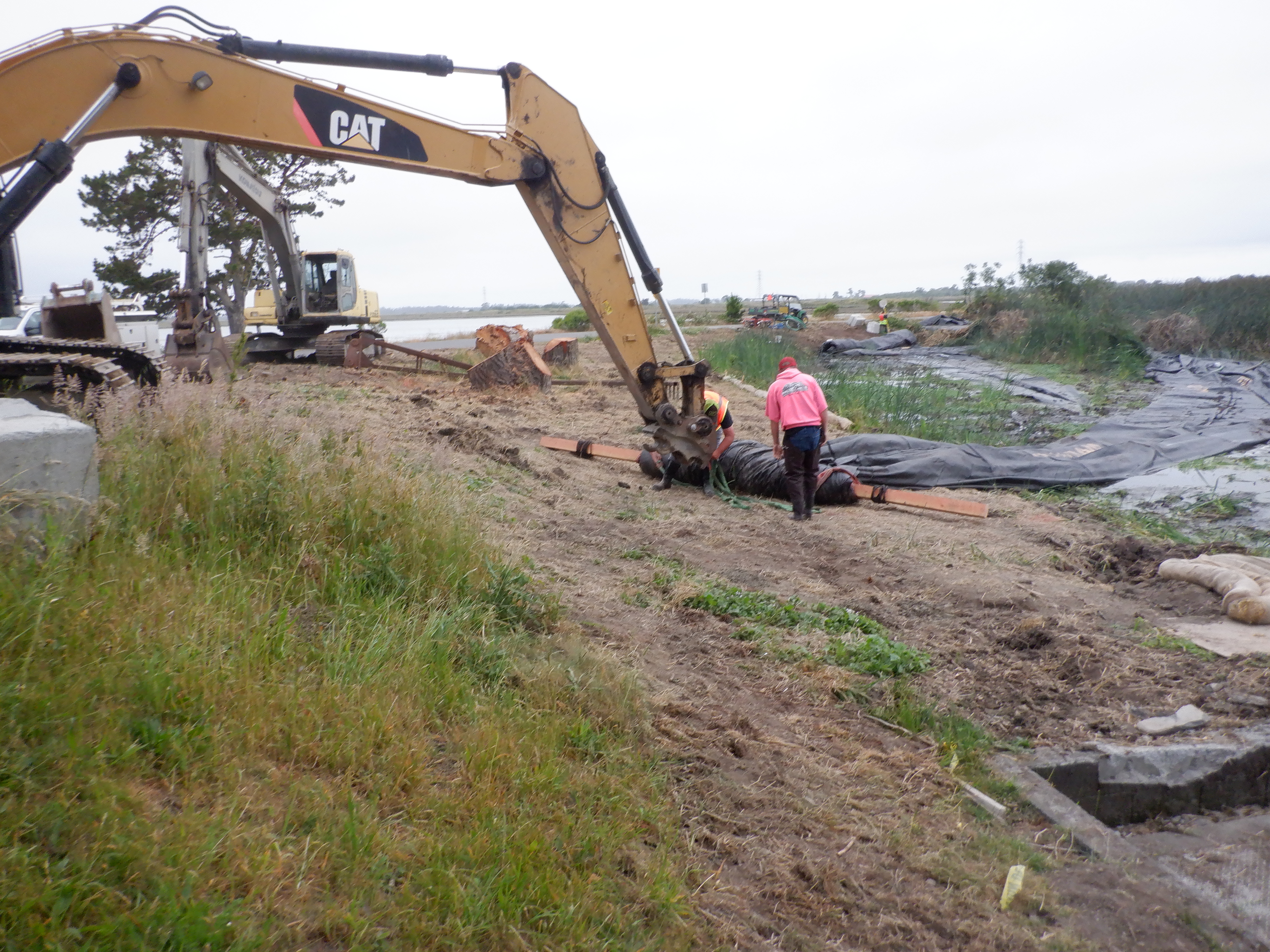
Workers secured a strap around the remaining rolled section of the dam and its supporting beam to facilitate pulling the unit out of the water.
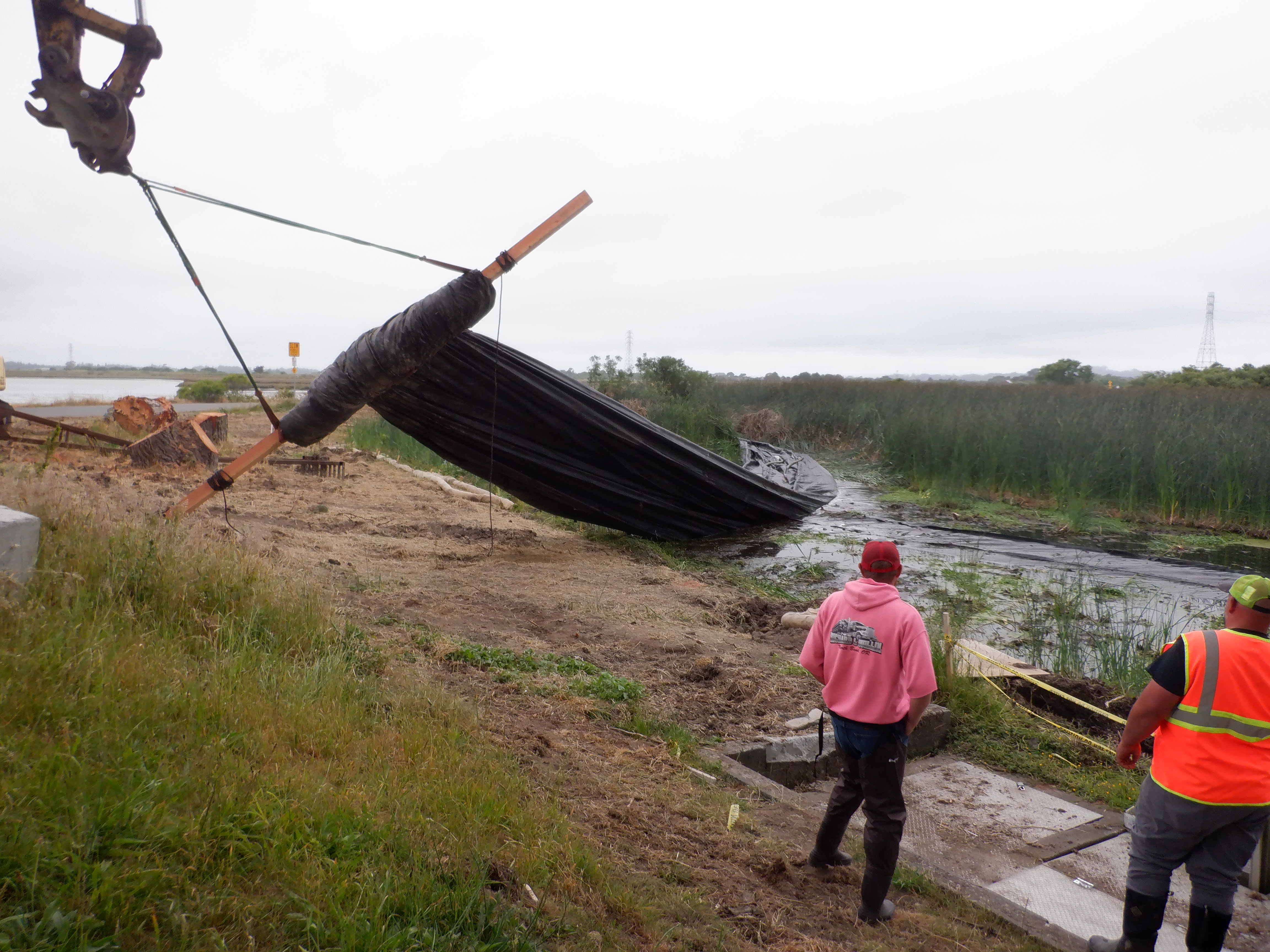
An excavator lifted and pulled the beam and the rolled end, forcing the water towards the open end of the AquaDam so it could drain back into Hauser Marsh.
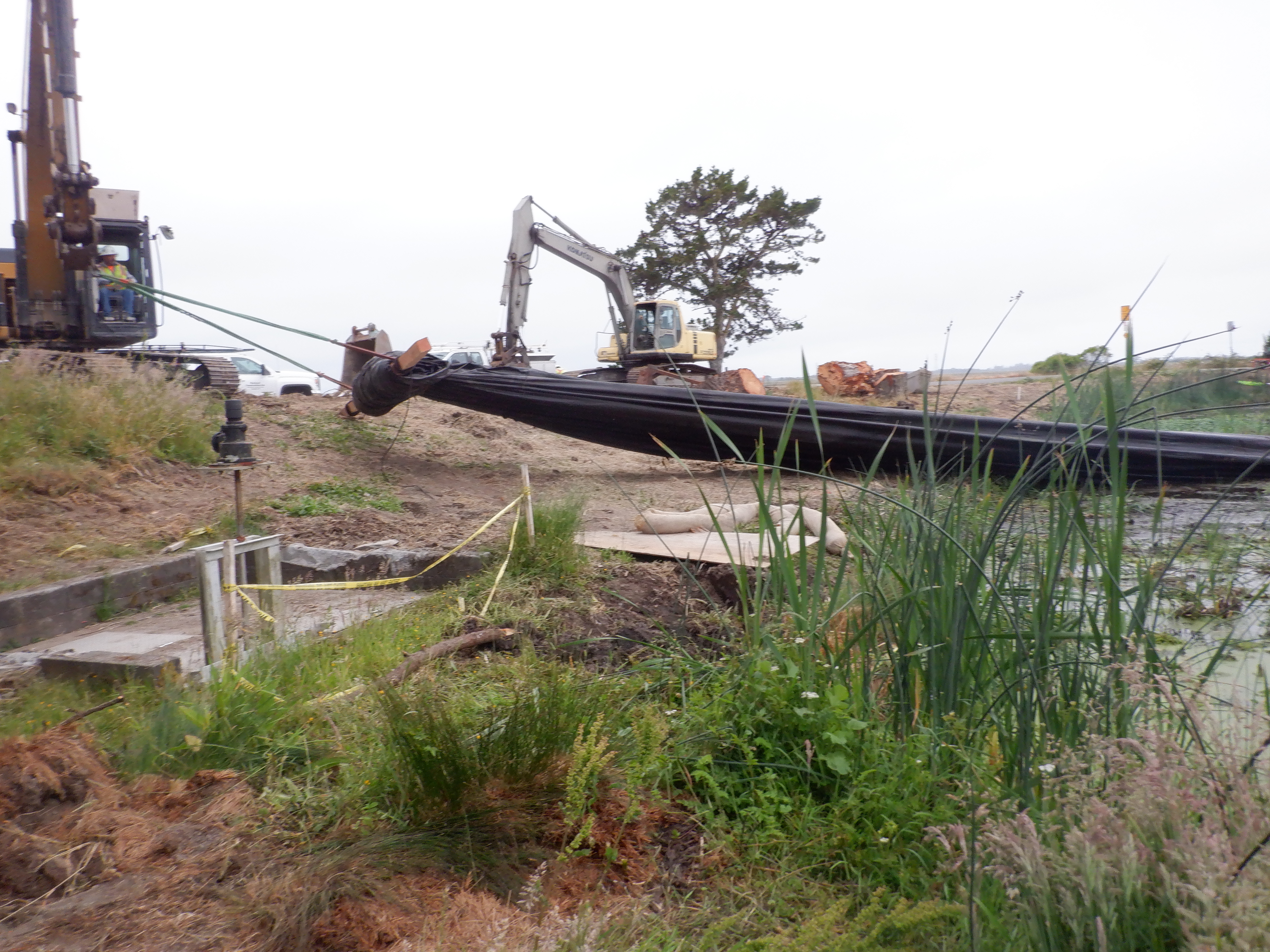
The operator lifted the end high for a few minutes to allow the water to drain, then lowered it and pulled.
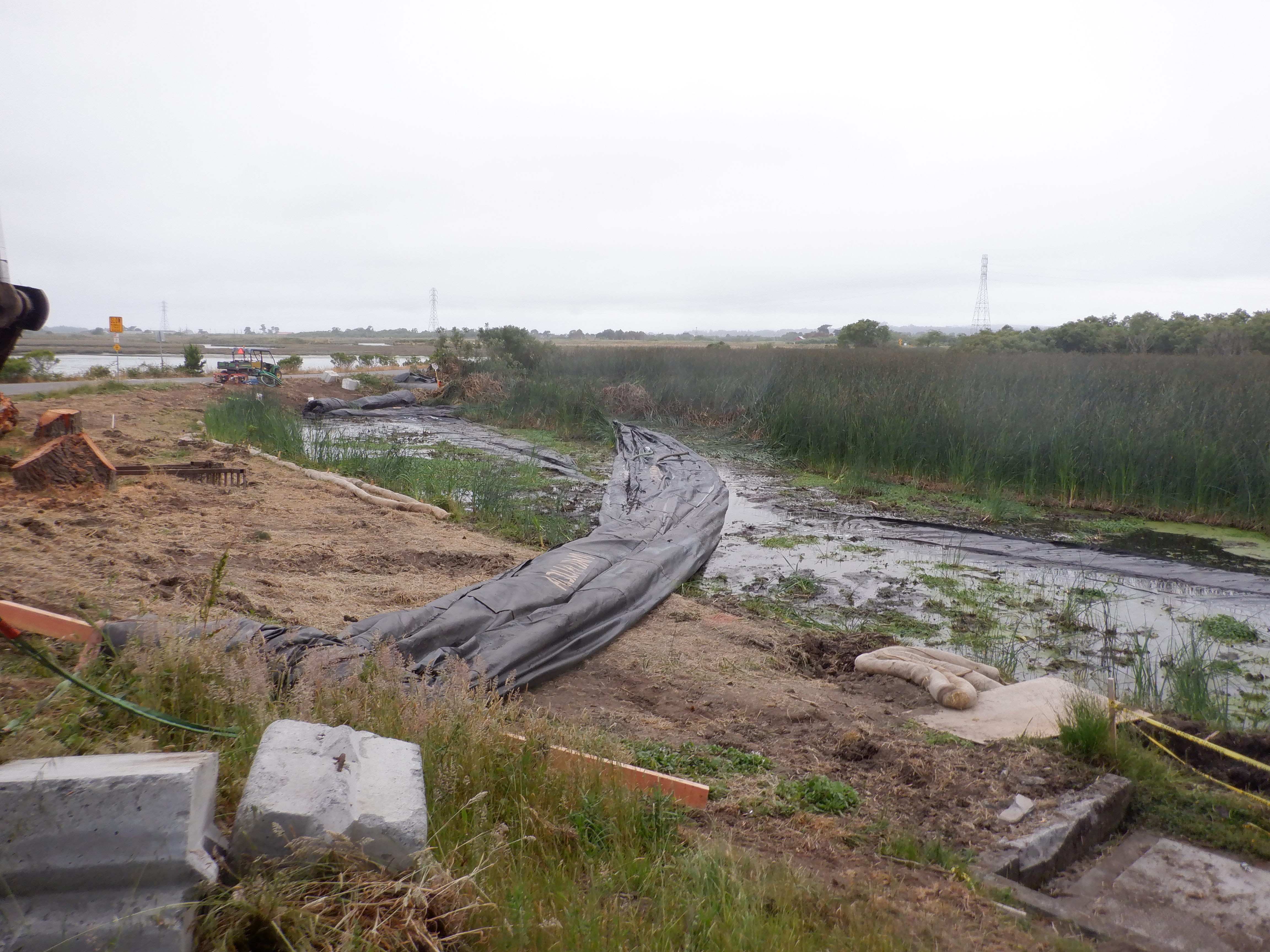
The removal process should be carried out slowly and with caution to maximize water drainage and prevent damage to the AquaDam®.
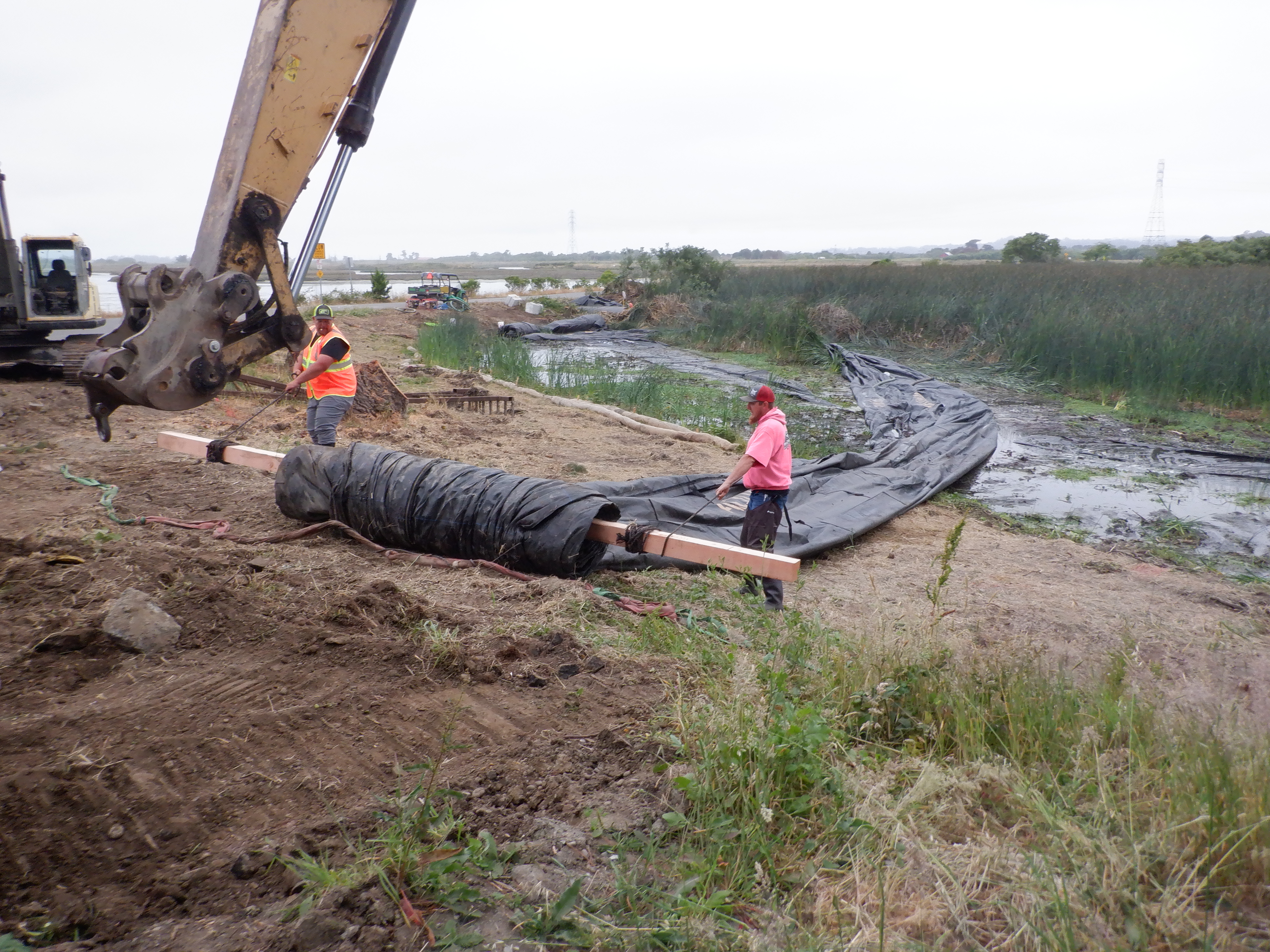
After several feet of the dam had been pulled out of the marsh and fully drained, workers began the re-rolling process. Ropes were securely wrapped around the beam ends in a manner that facilitated smooth and controlled re-rolling.
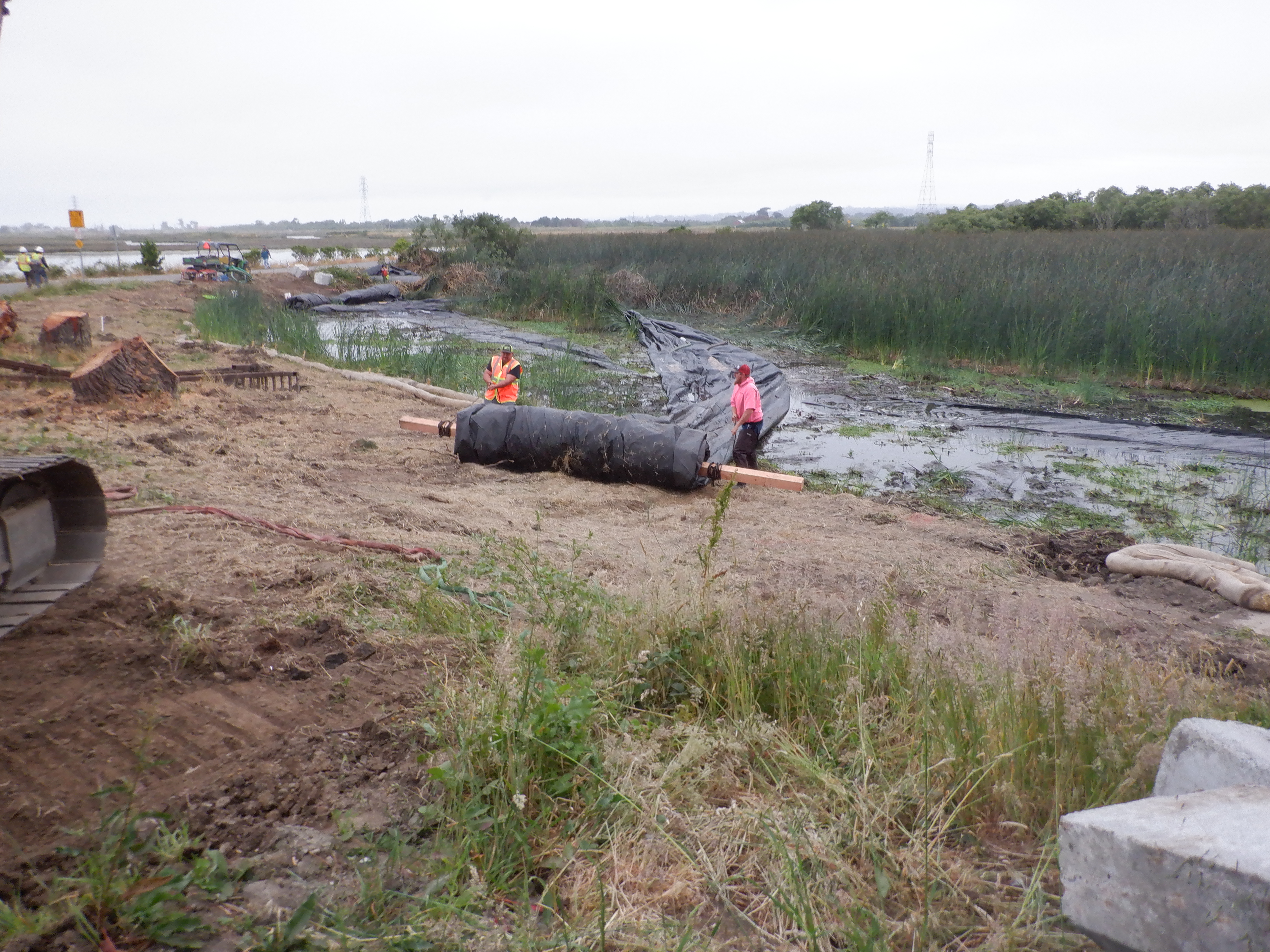
Workers manually re-rolled the AquaDam® as far as physically possible, continuing down to the water’s edge before mechanical assistance was required.
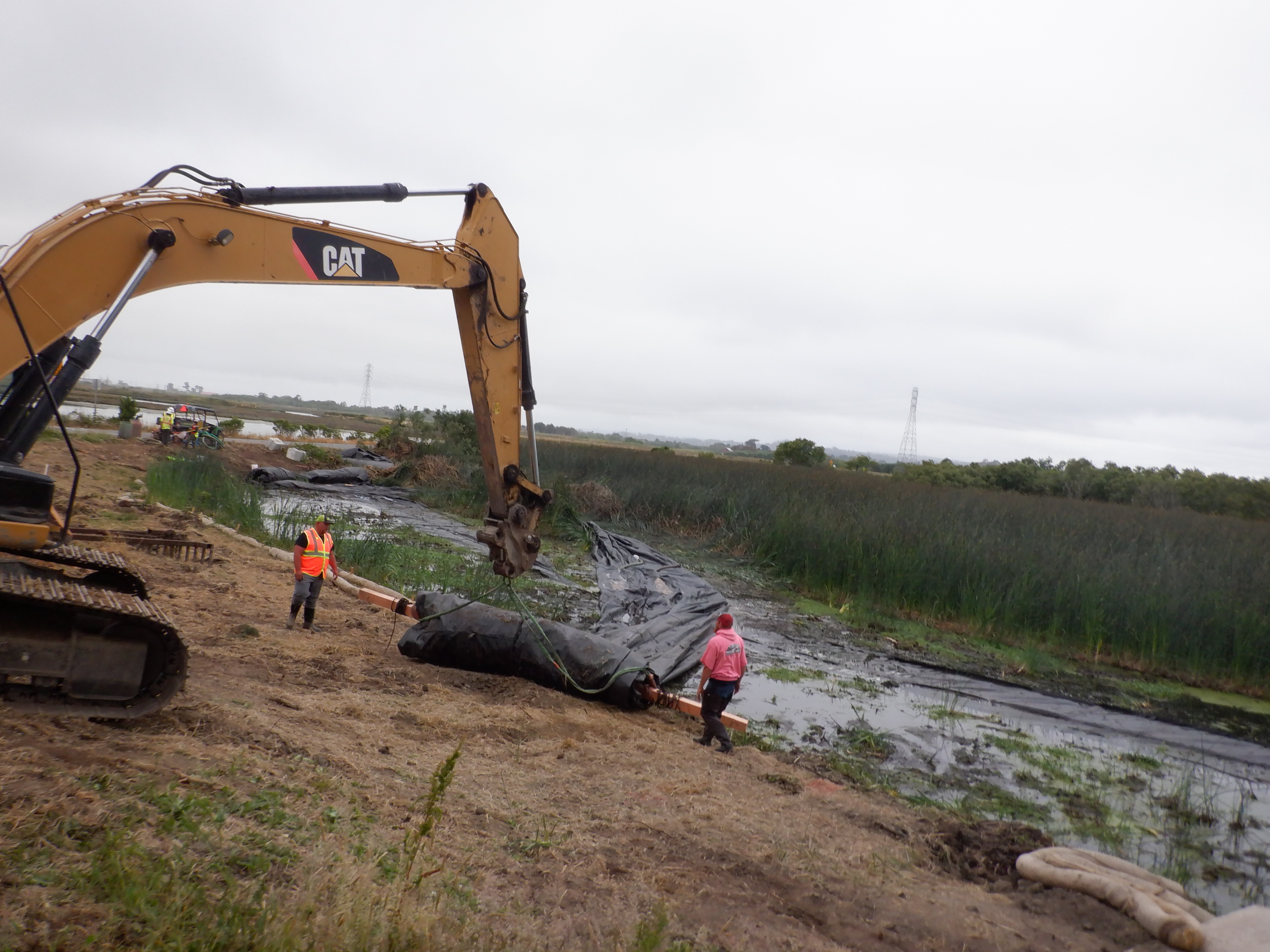
A strap was re-positioned around the roll and beam to facilitate additional lifting and pulling.
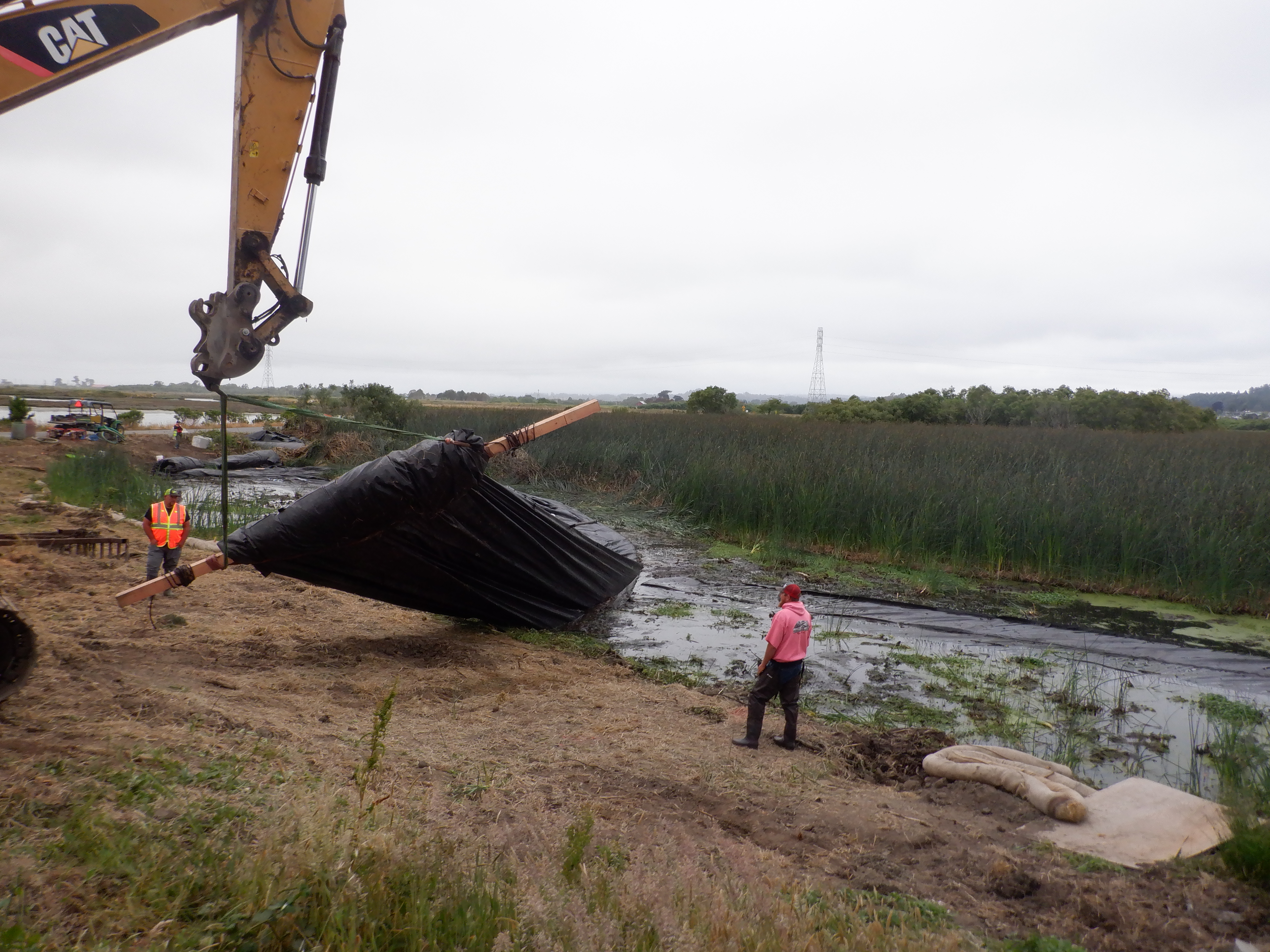
The removal process must be conducted slowly and deliberately, as excessive jerking or rapid movement can compromise the integrity of the AquaDam® material.
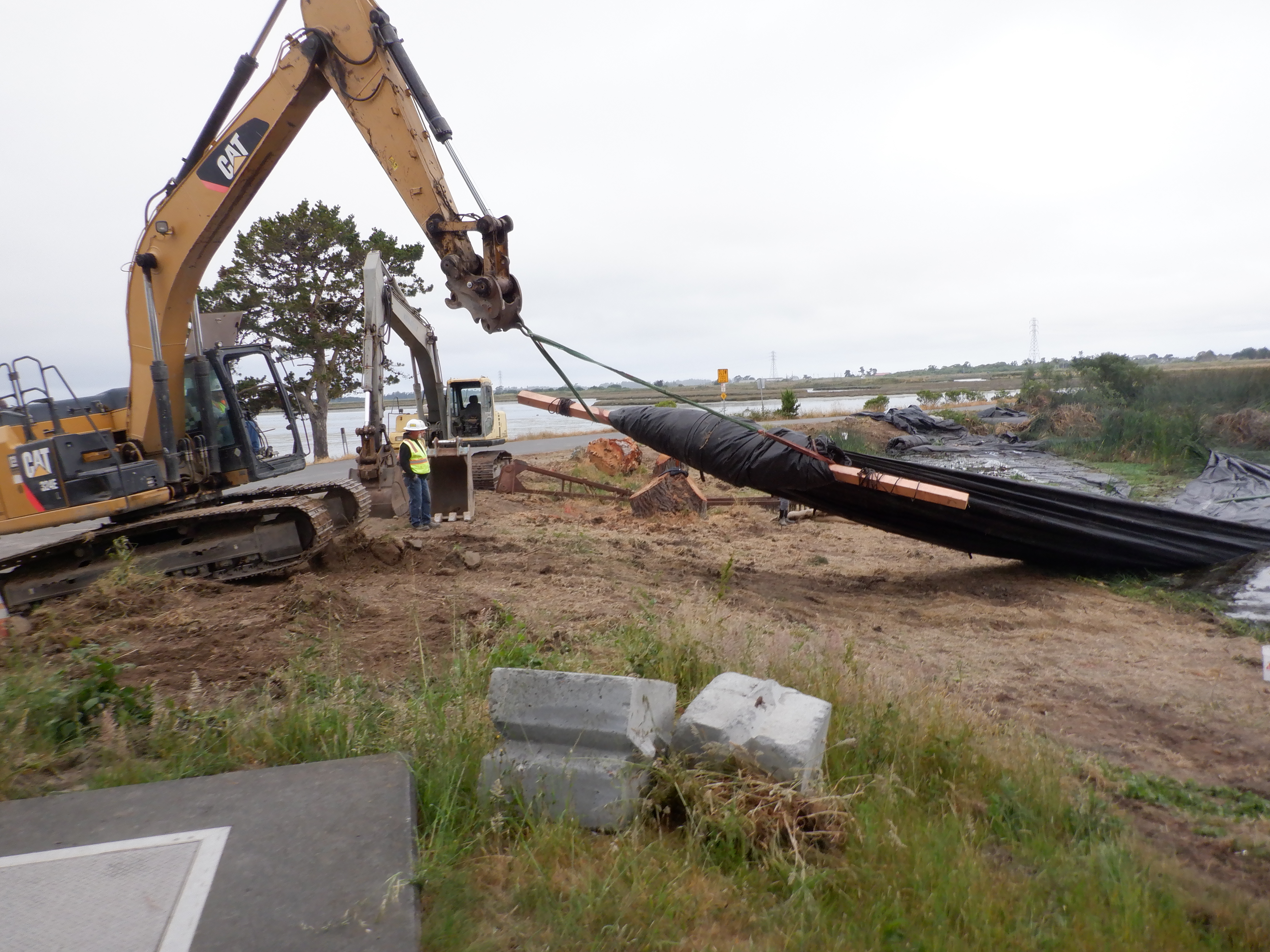
The excavator lifted the AquaDam® roll to direct internal water flow toward the marsh, then lowered the roll and resumed pulling to continue the removal process.
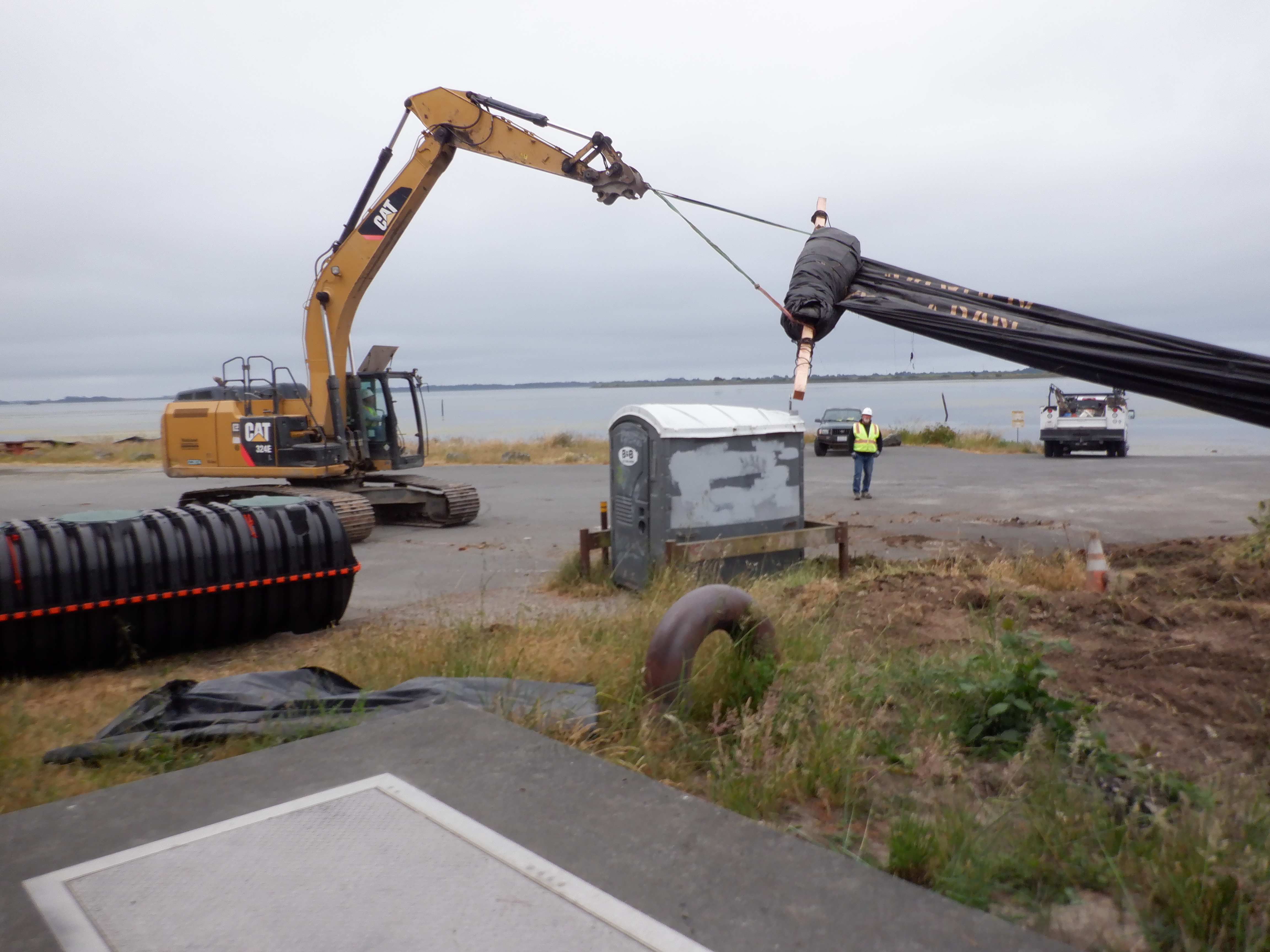
The 6ft tall, 270ft long SCE AquaDam® was also pulled into the adjacent parking lot to facilitate re-rolling. This open space provided a stable and accessible area for completing the re-rolling process and preparing the unit for transport.
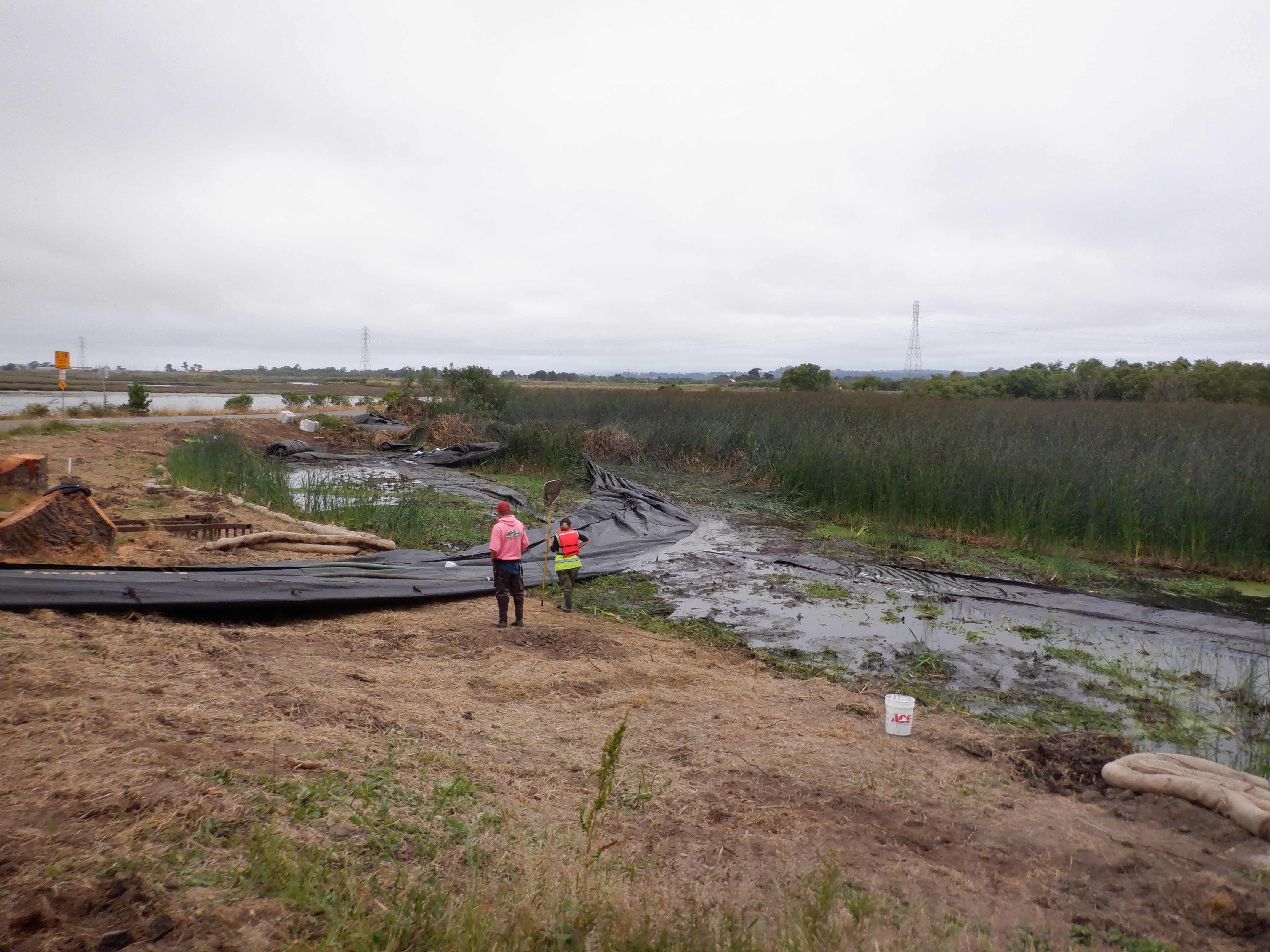
As the AquaDam® was pulled from the marsh, its open end and fill tubes remained behind, allowing the retained water to drain back into the marsh environment.
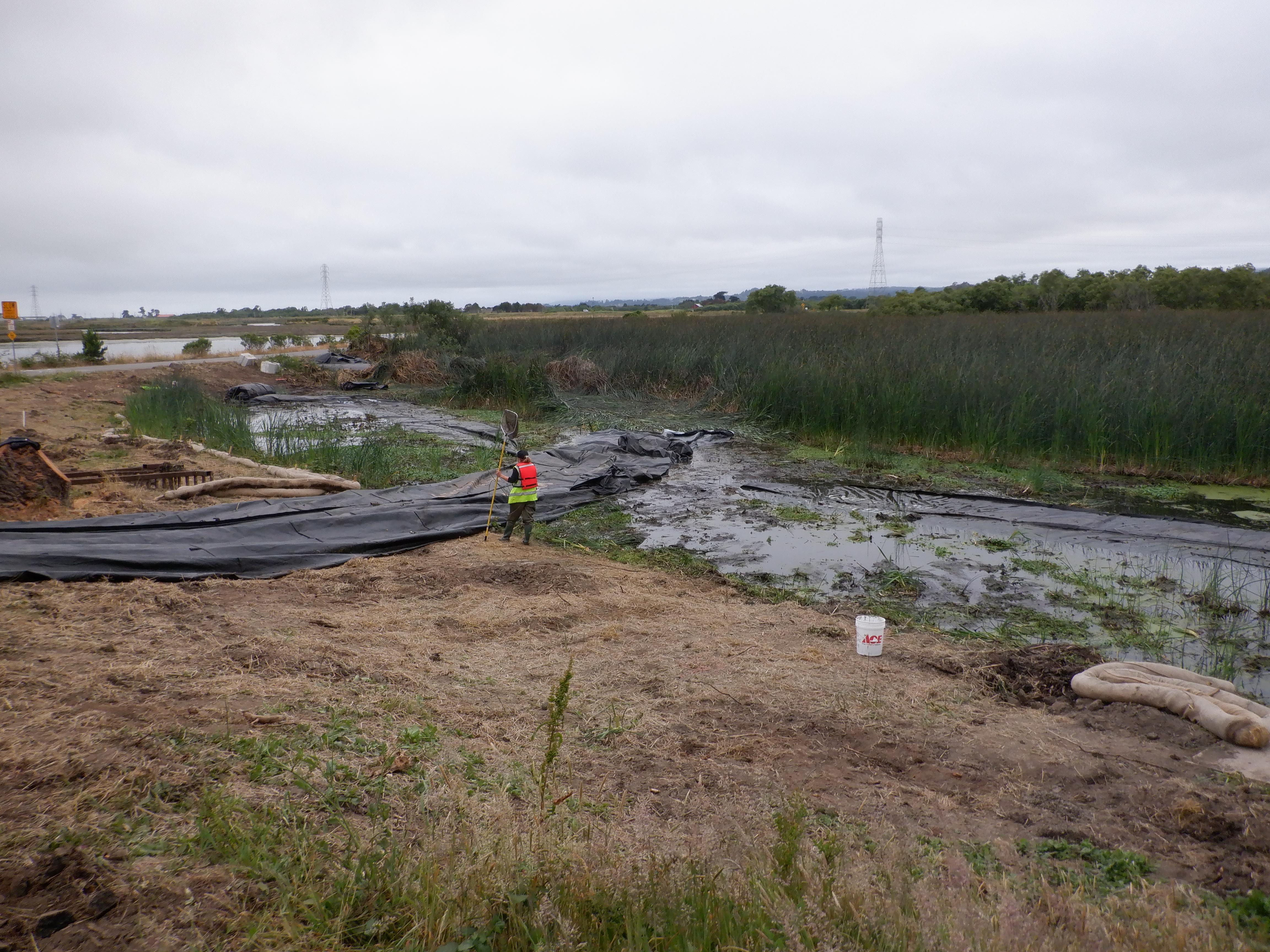
The AquaDam® material is physically drawn off the water surface during removal. Constructed from lightweight, flexible materials, empty AquaDams® are buoyant and will float when deployed in sufficiently deep water.
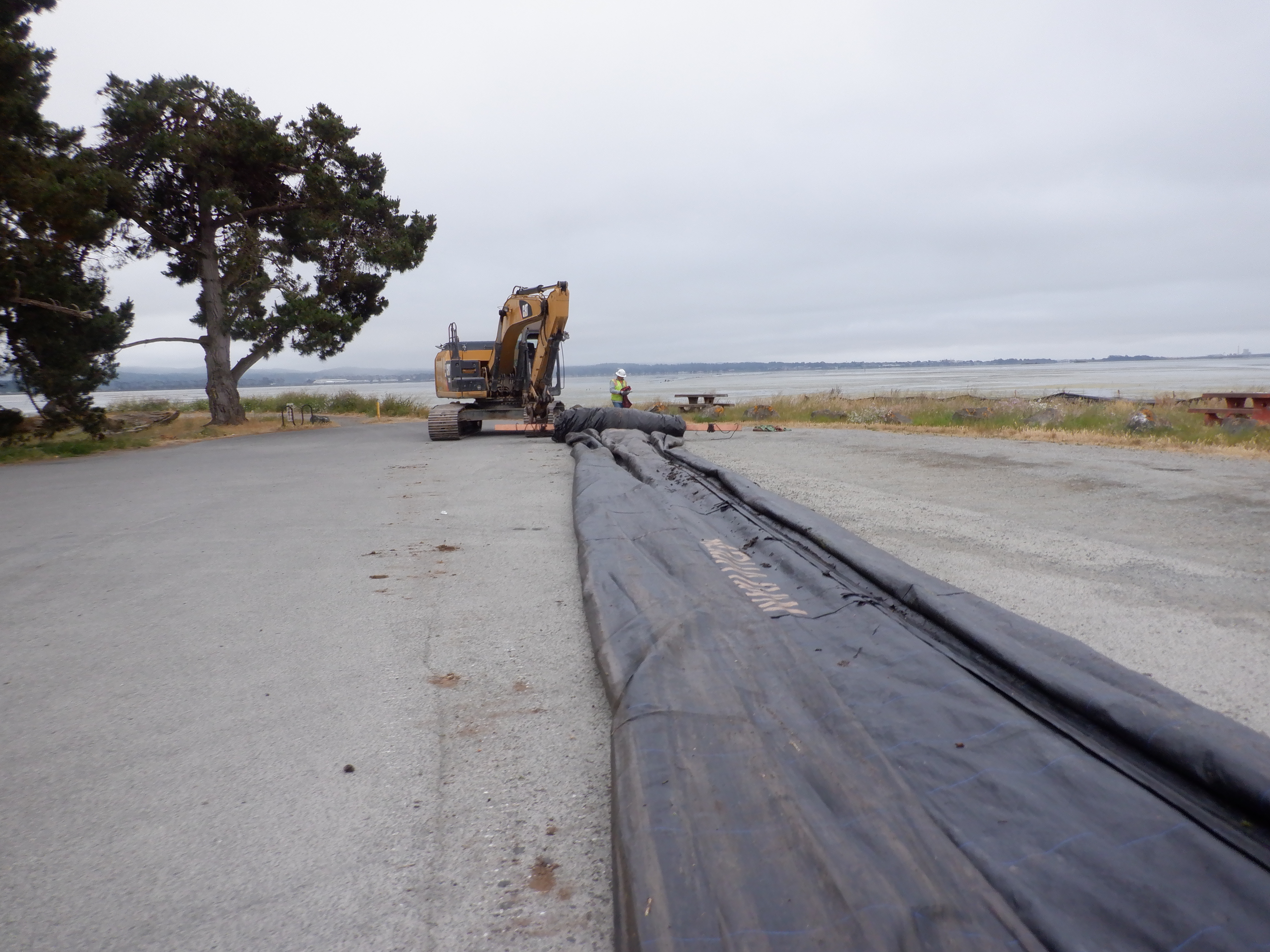
With the AquaDam® fully removed from the marsh, workers proceeded to re-roll the unit on the flat surface of the adjacent parking lot, taking advantage of the even terrain to ensure a clean and uniform roll-up.
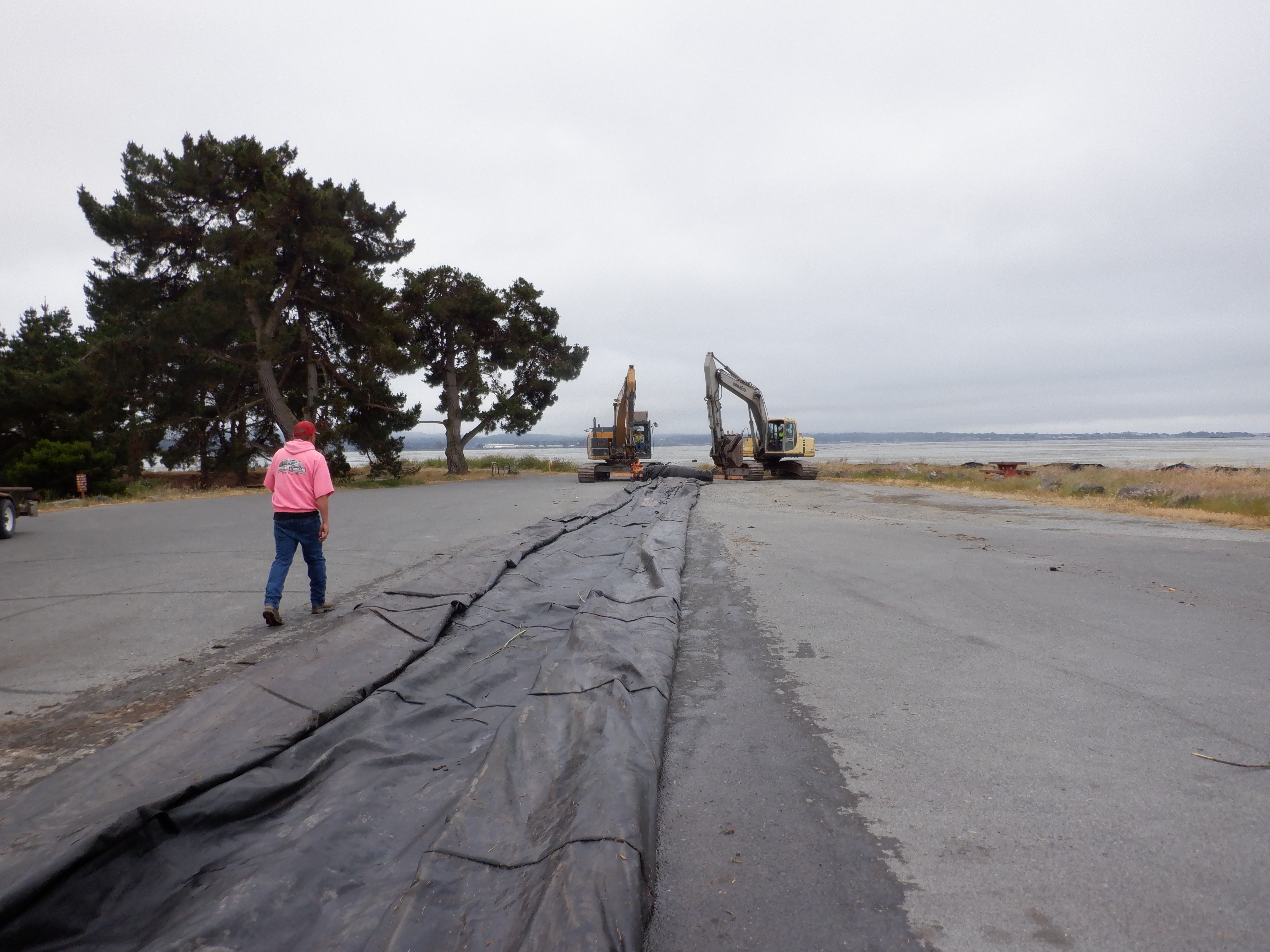
Workers folded in the sides to reduce the roll's width during the re-rolling process.
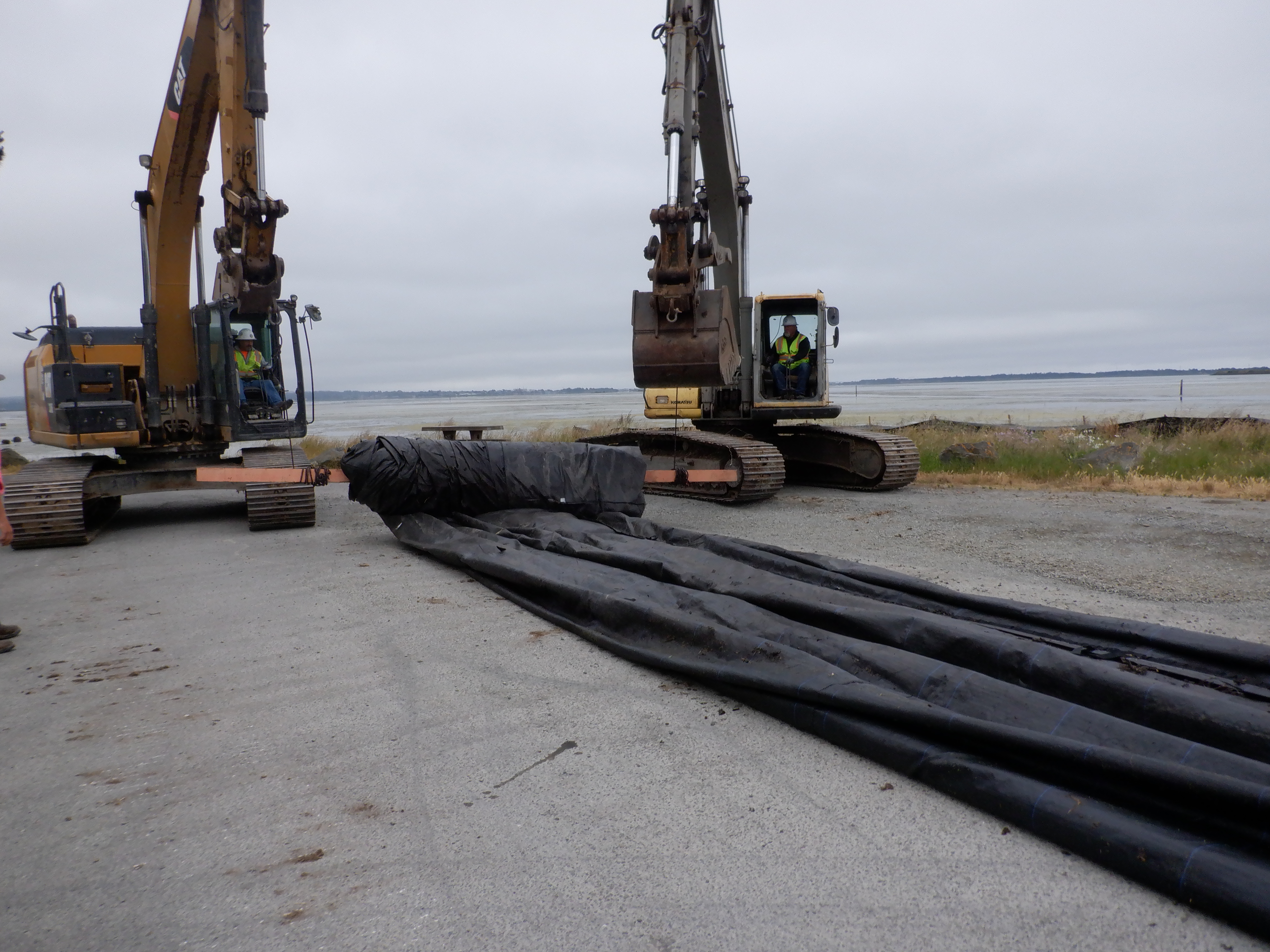
Utilizing two excavators was most effective; this approach maintains the ropes' near-vertical alignment during the process, without a spreader bar.
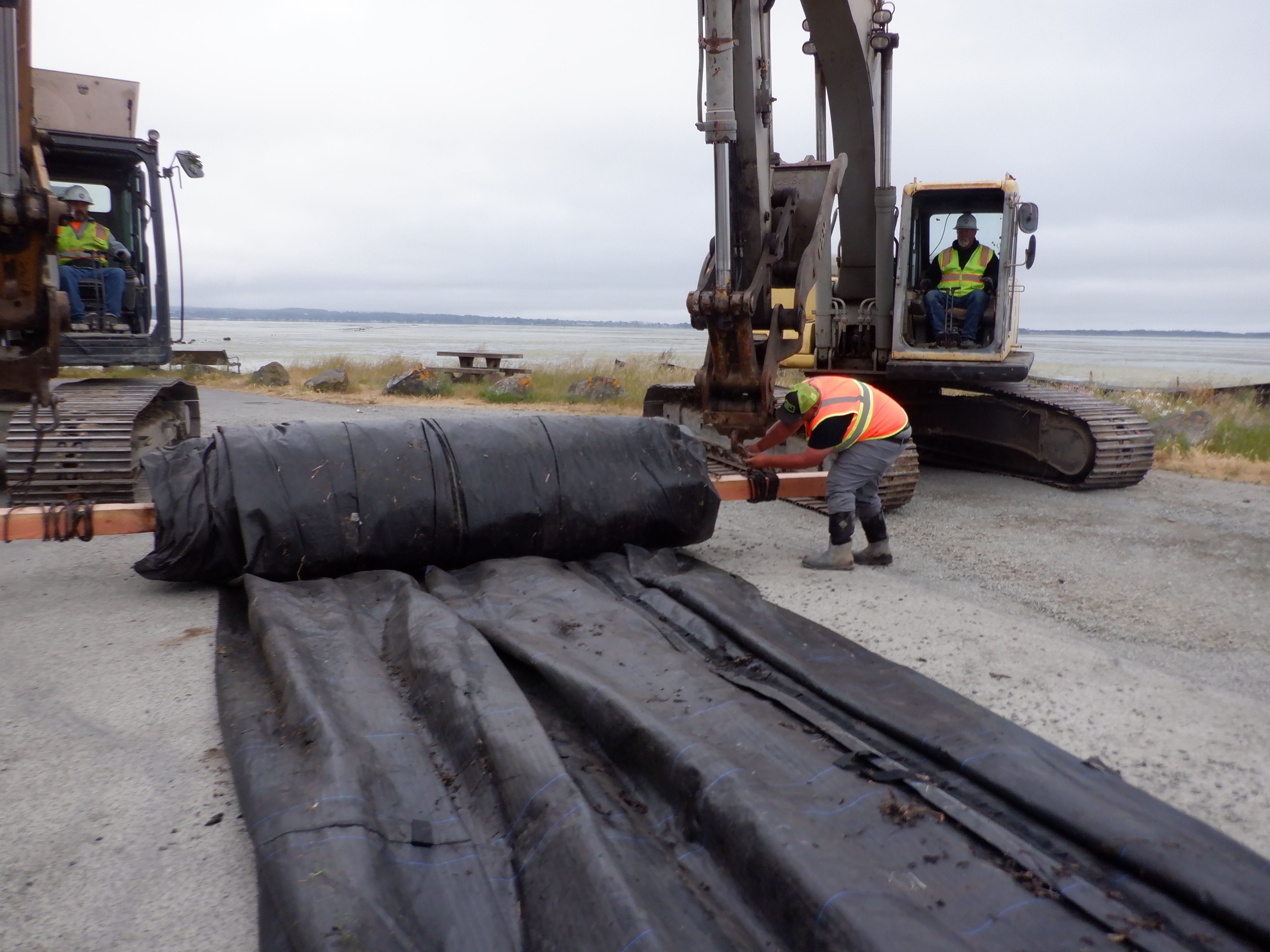
Once the ropes reached their maximum extension, workers re-secured them around the beam in a new position, allowing the excavators' lifting action to continue the re-rolling of the AquaDam®.
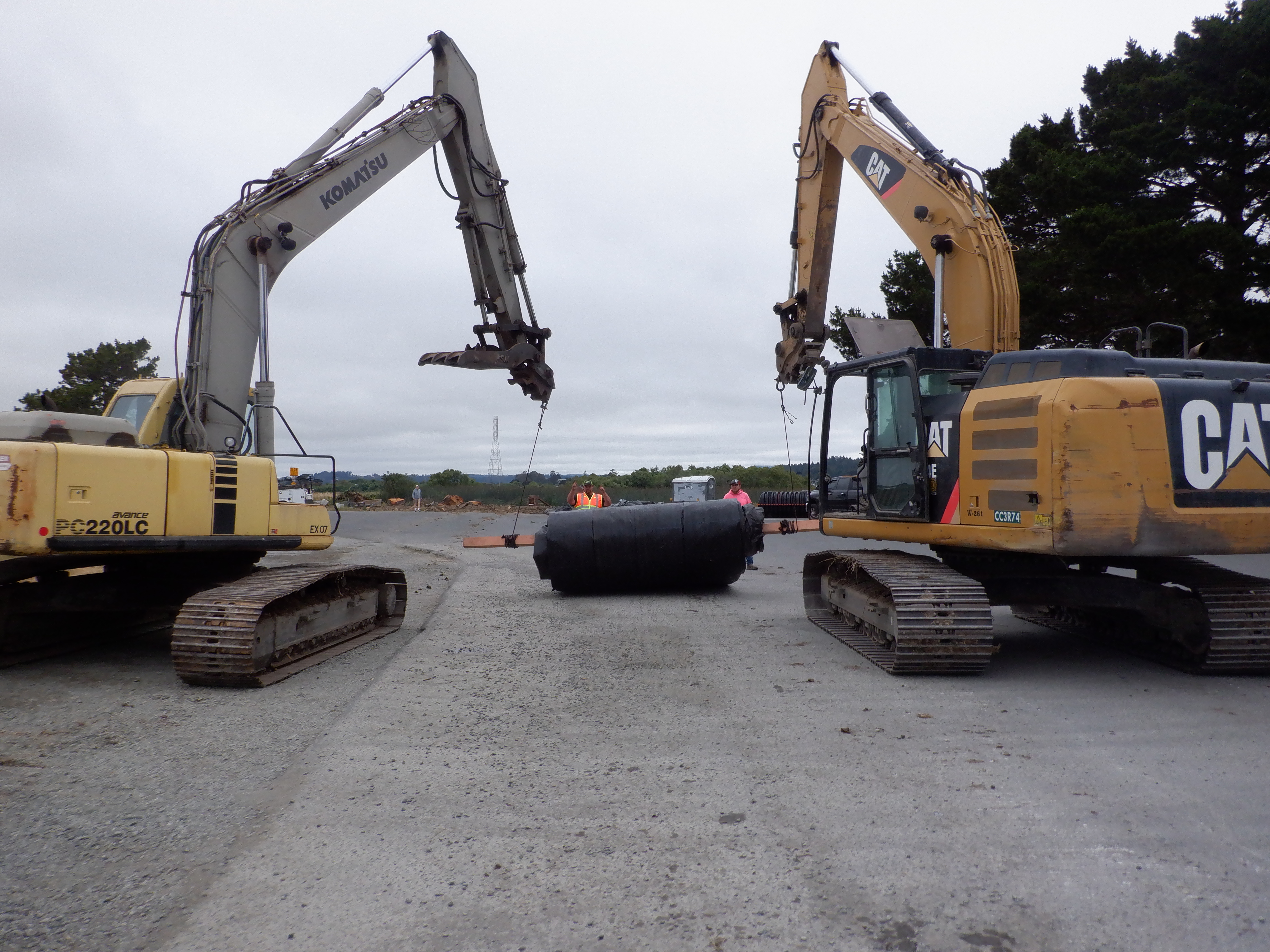
To ensure proper re-rolling of the AquaDam®, both excavators must lift and move in coordinated unison, maintaining even tension and alignment throughout the process.
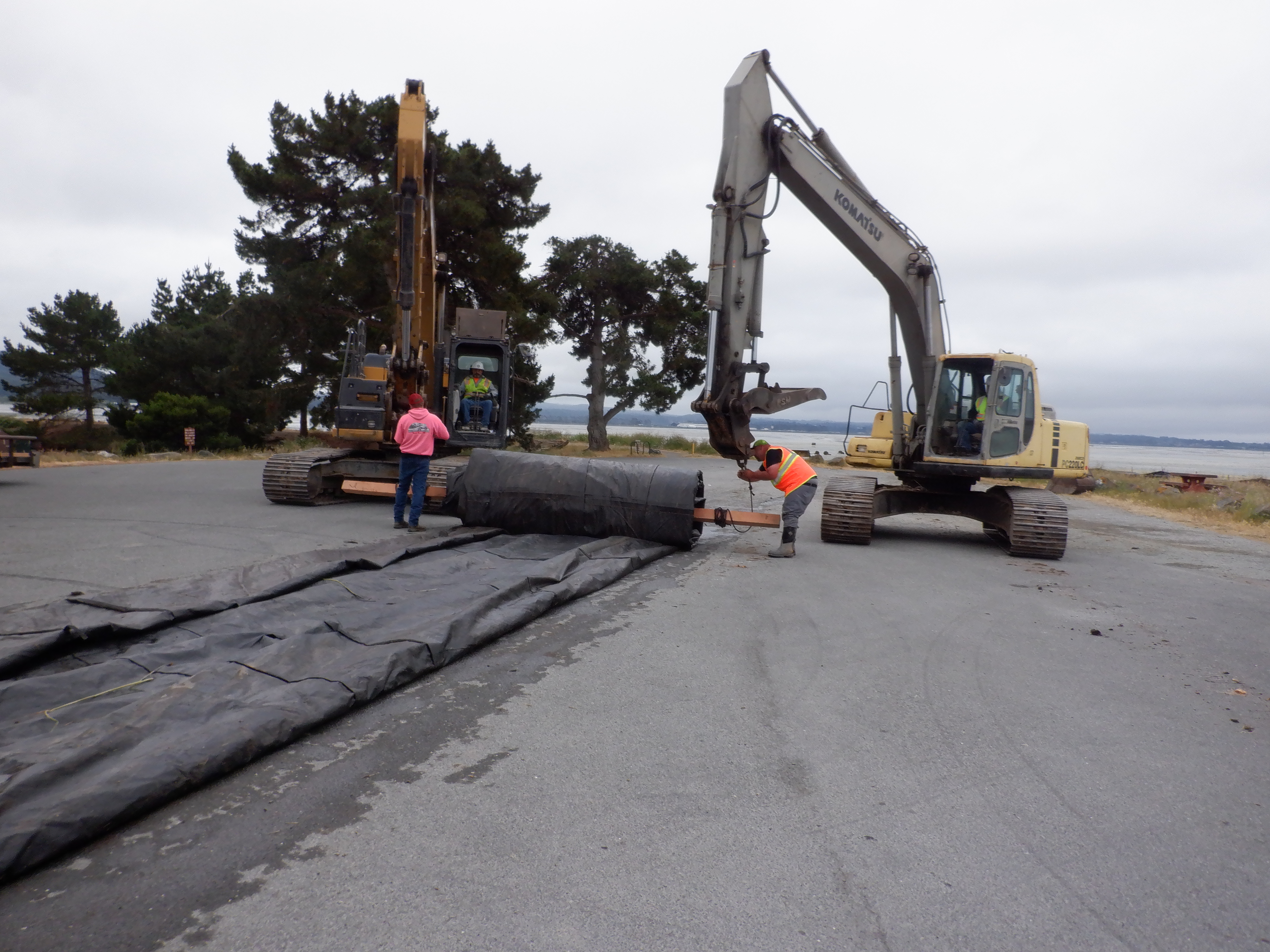
The re-rolling process is inherently slow and requires multiple iterations to ensure proper alignment and minimize stress on the AquaDam® material.
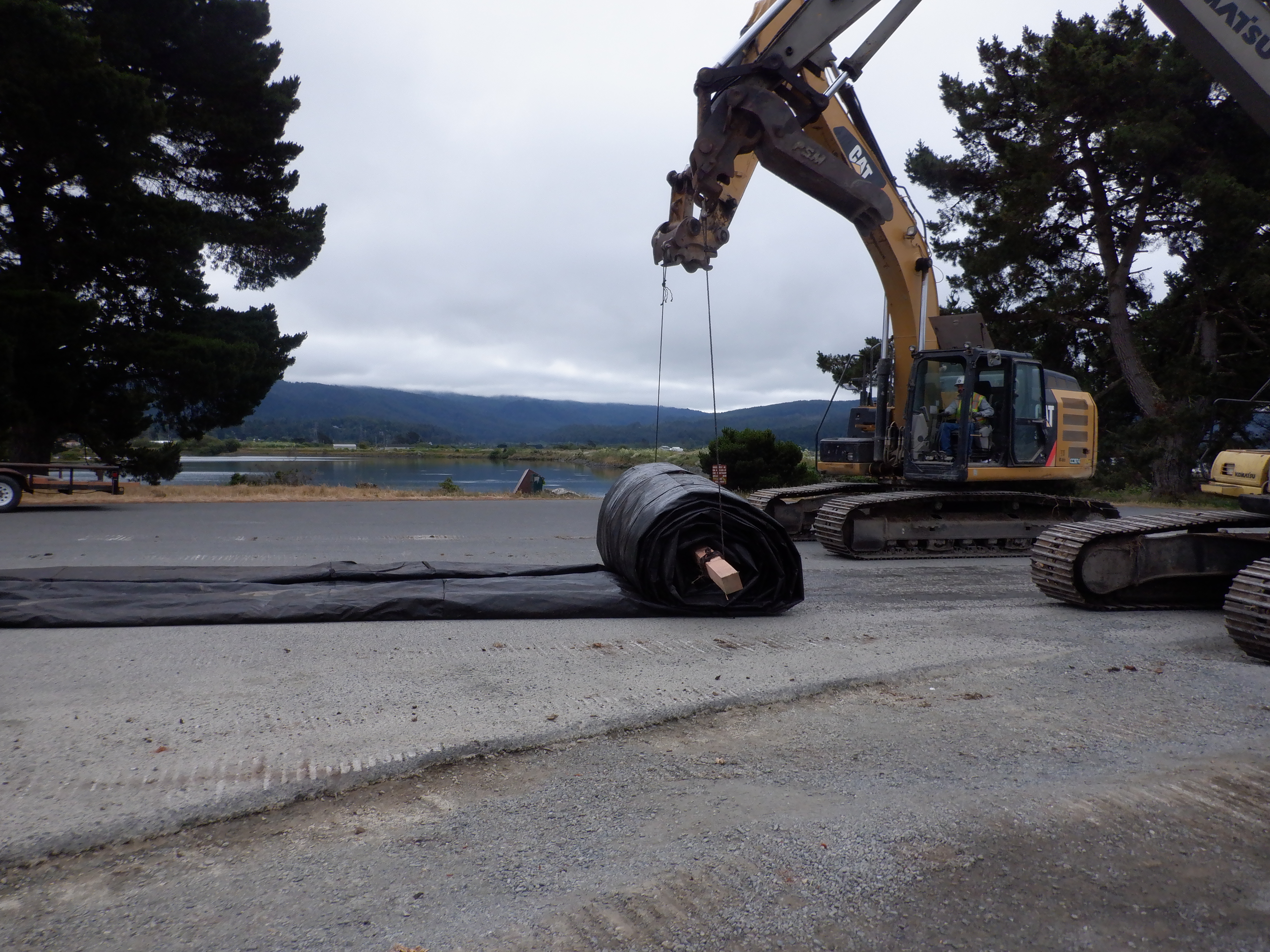
The excavators lift the pre-wrapped ropes, causing the AquaDam® to rotate until the ropes reach their full extension. Workers then reposition and re-wrap the ropes to repeat the process, continuing the re-rolling sequence in measured stages.
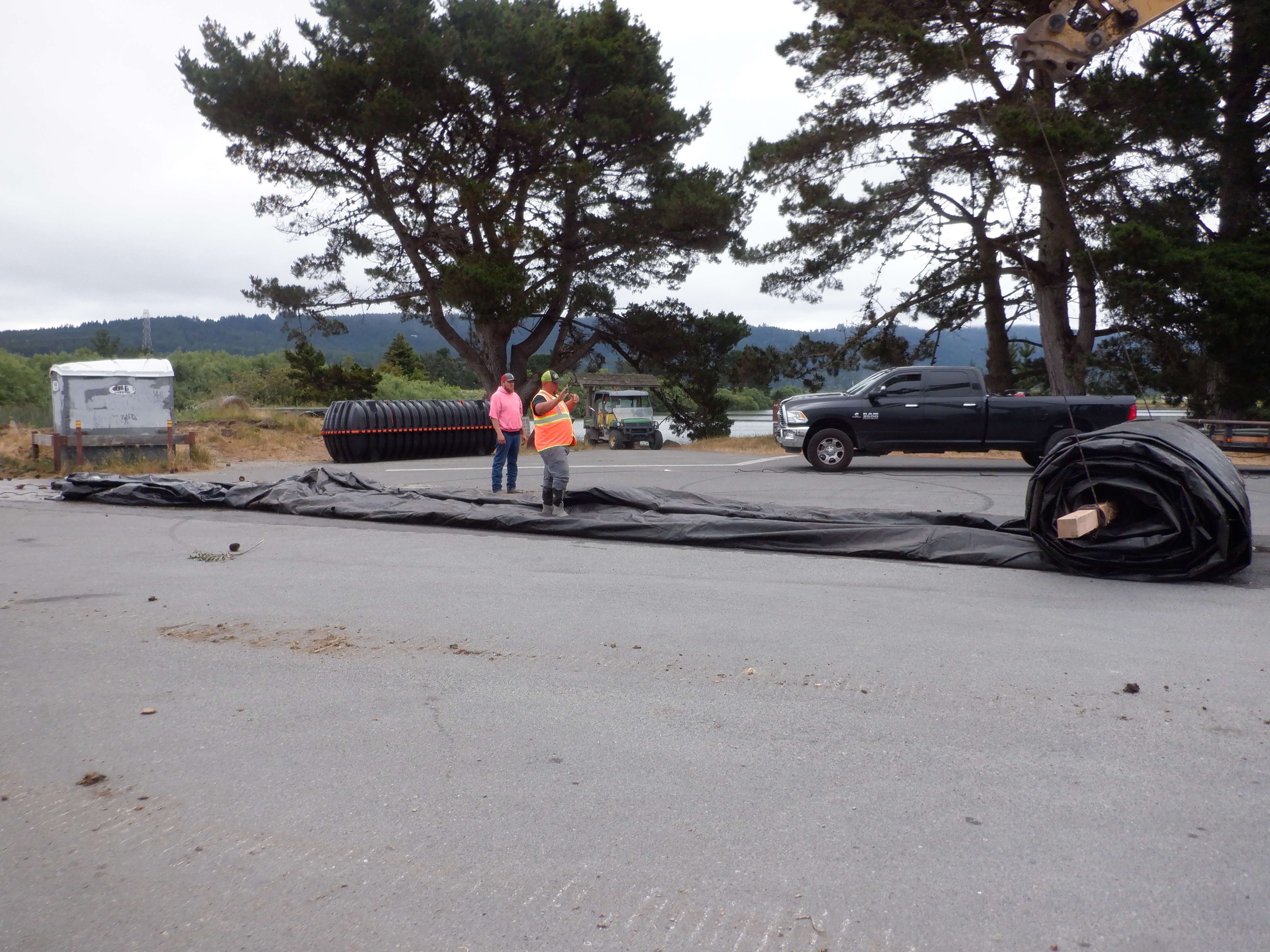
As the roll began to loosen and lose tension, workers secured the ropes to prevent further unintentional rotation. The excavators then lifted the roll, and this upward tension re-tightened the AquaDam® material, restoring firmness and alignment.
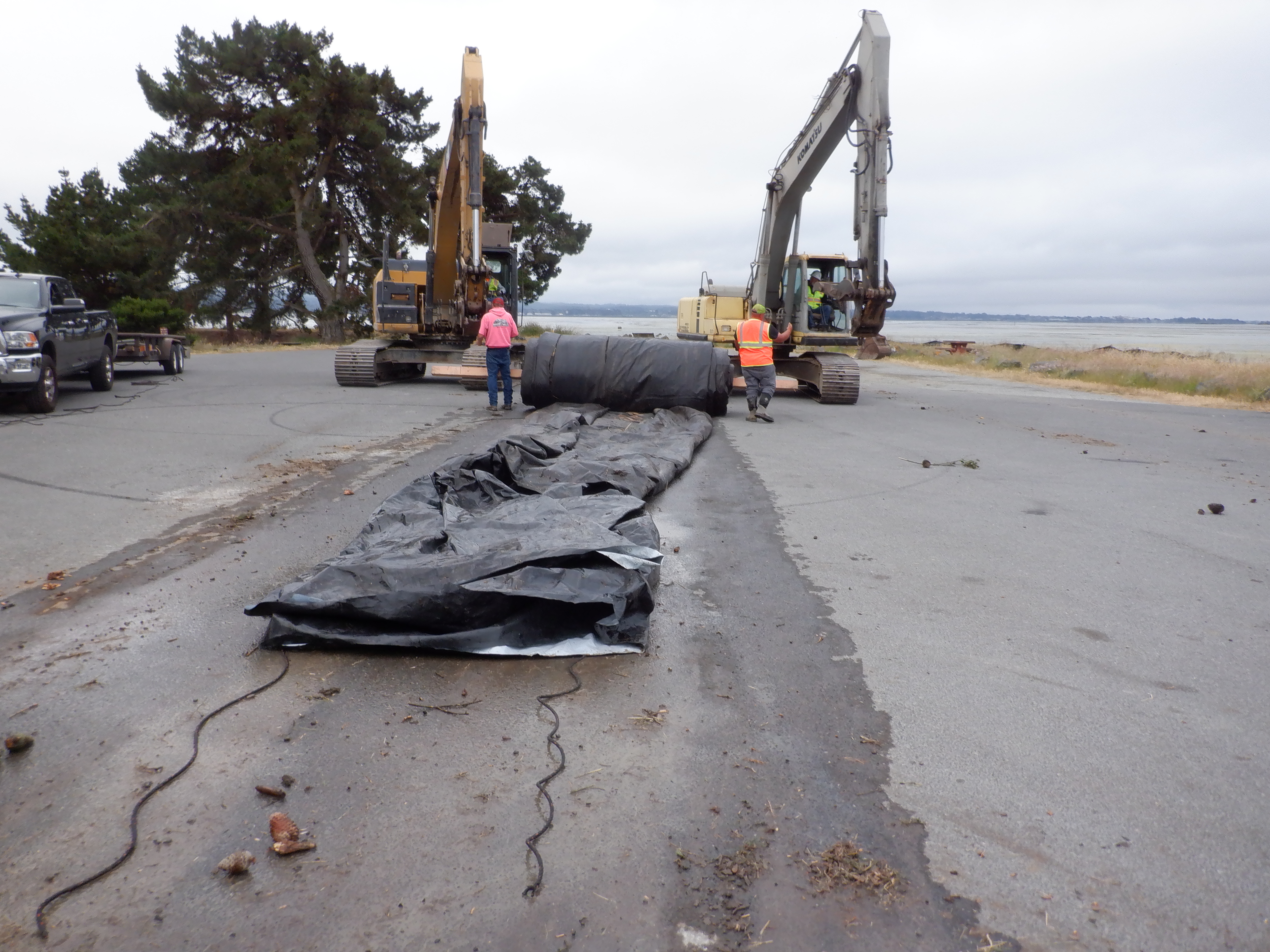
Just before completing the roll-up, workers positioned two lengths of rope beneath the AquaDam®. These ropes serve a dual purpose: securing the completed roll and facilitating safe lifting and transport of the unit.
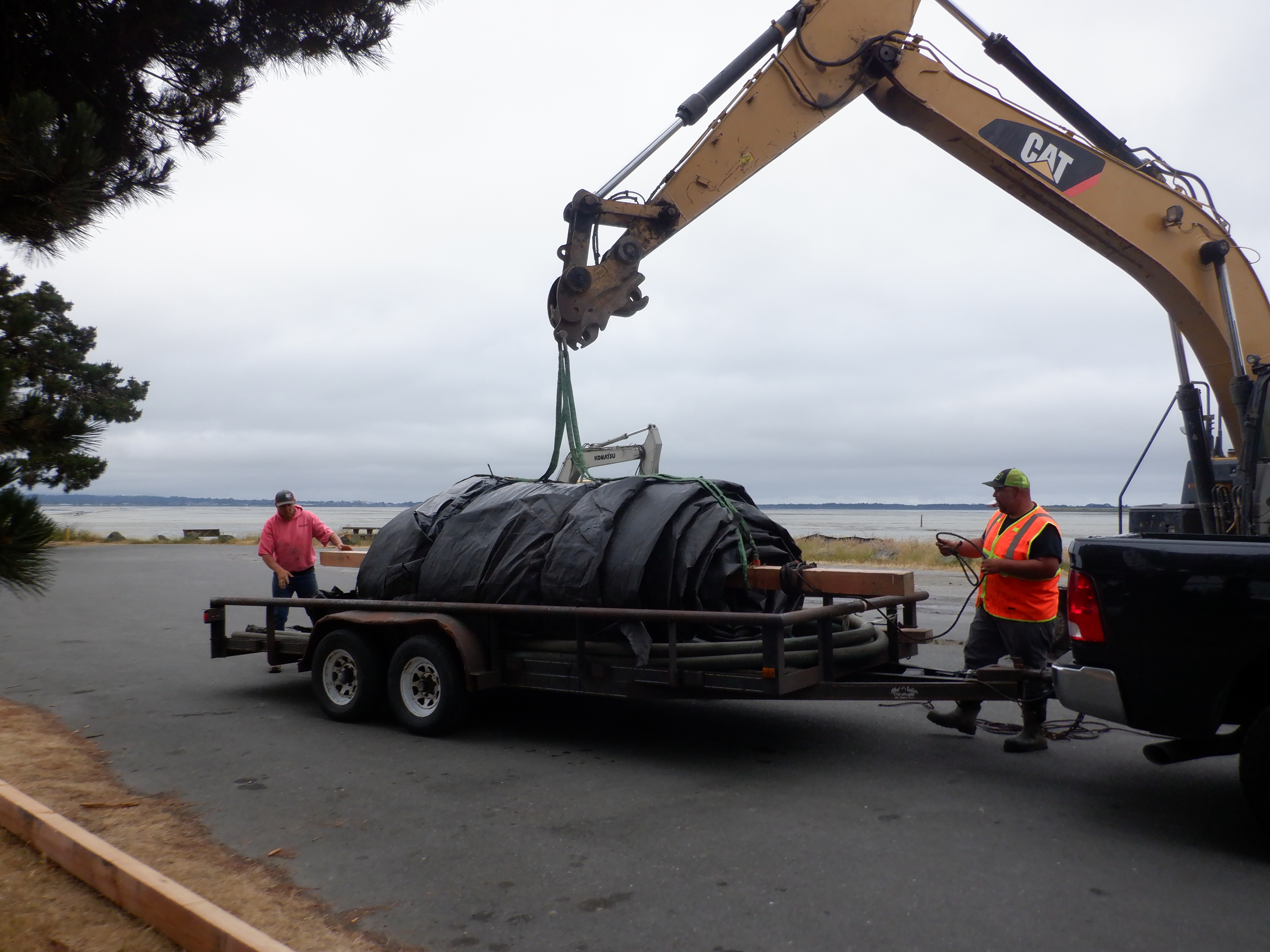
Excellent work, AquaDam®!
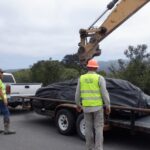
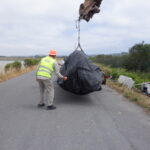
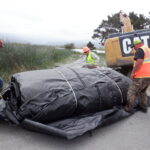
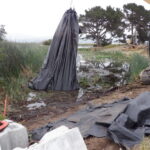
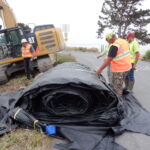
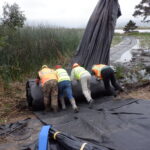
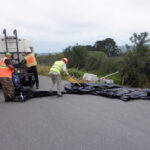
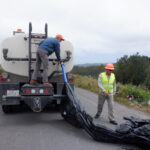
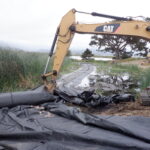
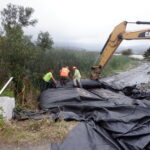
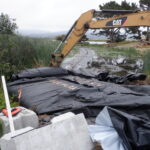
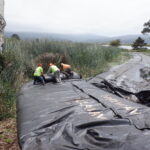
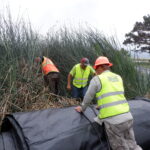
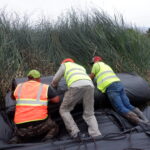
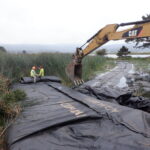
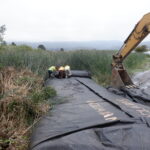
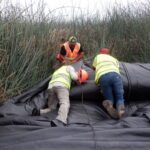
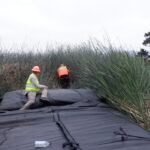
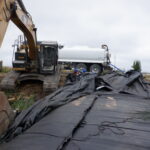
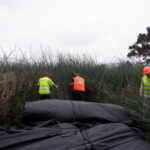
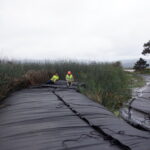
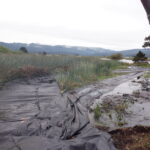
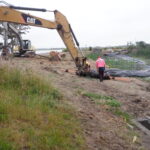
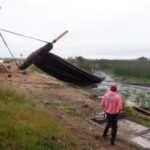
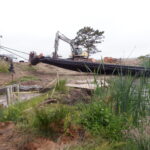
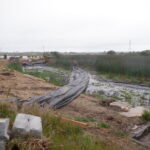
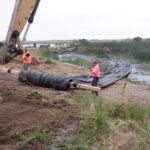
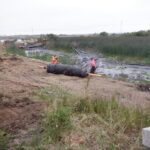
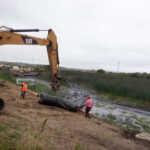
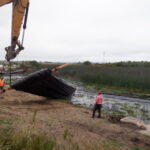
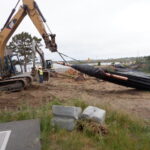
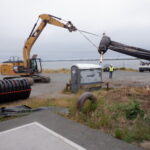
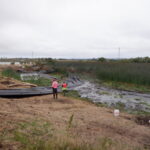
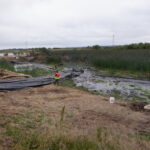
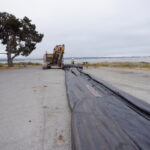
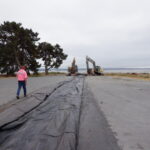
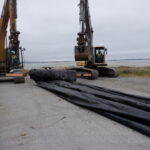
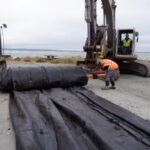
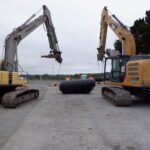
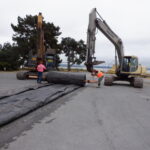
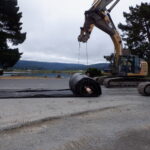
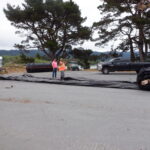
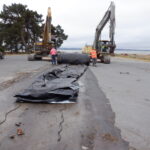
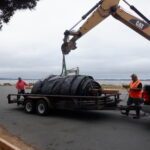
6ft Tall 13ft Wide (fully filled) 270ft Long Single Closed End (SCE) AquaDam®, Arcata Wastewater Treatment Plant, Arcata Marsh & Wildlife Sanctuary, Hauser Marsh, Enhancement Wetlands, Tidal Influence, Water Truck Fill, Line Configuration, Installation & Removal
